Having bathroom plants offers several benefits, such as helping purify the air and adding color to bland surroundings.
Additionally, many plants kept in bathrooms can help get rid of harmful bacteria and absorb extra moisture from the air. However, finding the right plant can be quite challenging if you have a bathroom that gets very little light.
That’s why I’ve put together this detailed guide on the topic to help you out.
1. Bird’s Nest Fern (Asplenium nidus)
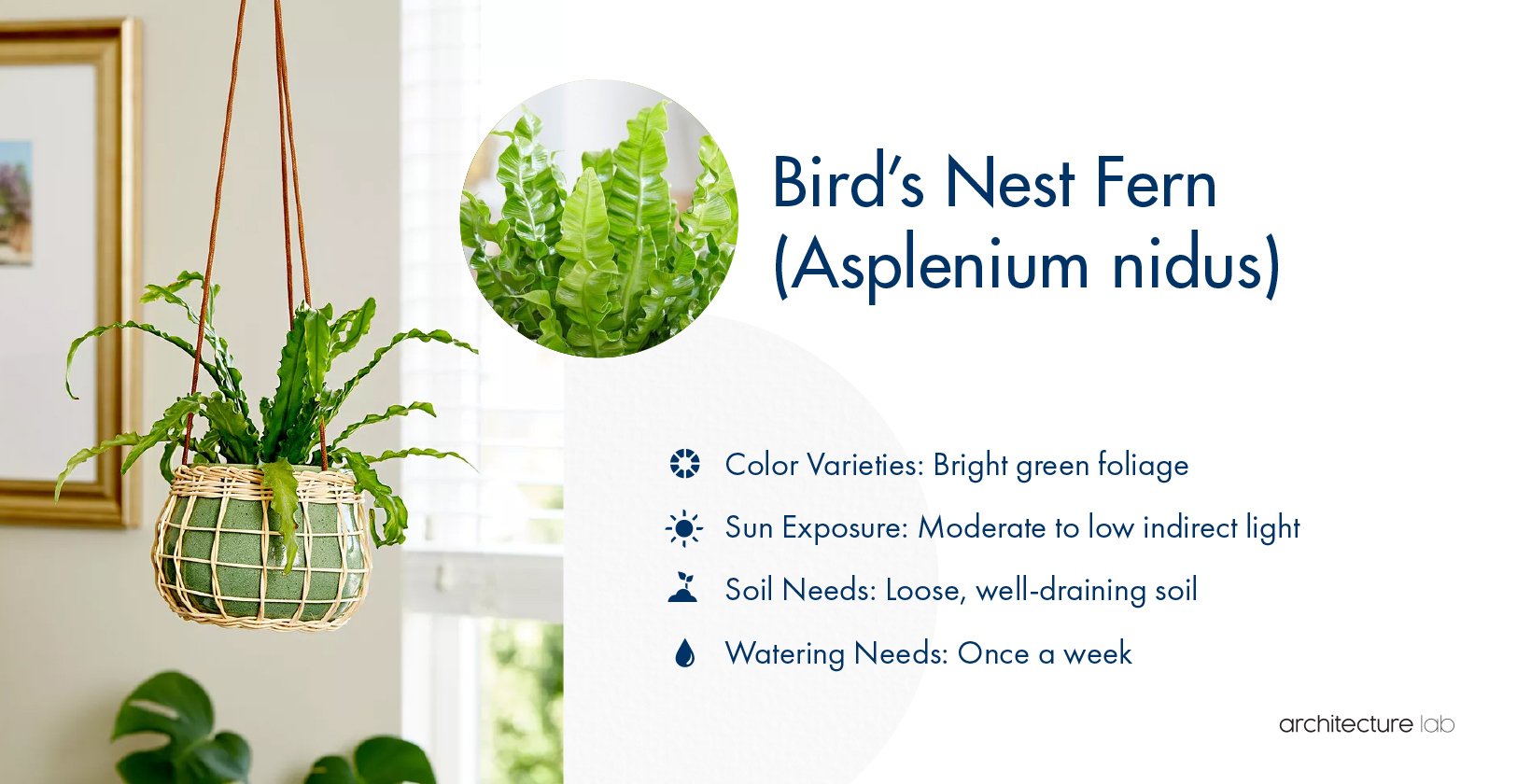
The Bird’s nest fern, also known as nest fern, is found in many areas, such as Southeast Asia, Hawaii, eastern Australia, eastern Africa, India, and Christmas Island. It has large, spoon-shaped fronds that are bright green, with wavy or crinkled leaves that can resemble banana leaves.
There is also a central fuzzy rosette from where new fronds emerge, which makes the plant look like a bird’s nest, hence the name. This fern thrives well in medium to low indirect light and prefers high humidity, making it perfect for bathrooms. It can grow up to two to four feet tall and is non-toxic.
The fern requires soil rich in organic matter, such as peat moss, and has a slow-growth rate. It should ideally be planted in spring, and the ideal temperature range should be between 60 and 80 degrees Fahrenheit.
These plants are also not particularly susceptible to diseases, but insects like mites, shore flies, and aphids can damage the foliage. Insecticides and pesticides can help get rid of them, you can also pair them with plants that keep mosquito, flies and other insects away for a winning combination.
Color Varieties: Bright green foliage | Sun Exposure: Moderate to low indirect light | Soil Needs: Loose, well-draining soil | Watering Needs: Once a week
2. Orchids (Orchidaceae)
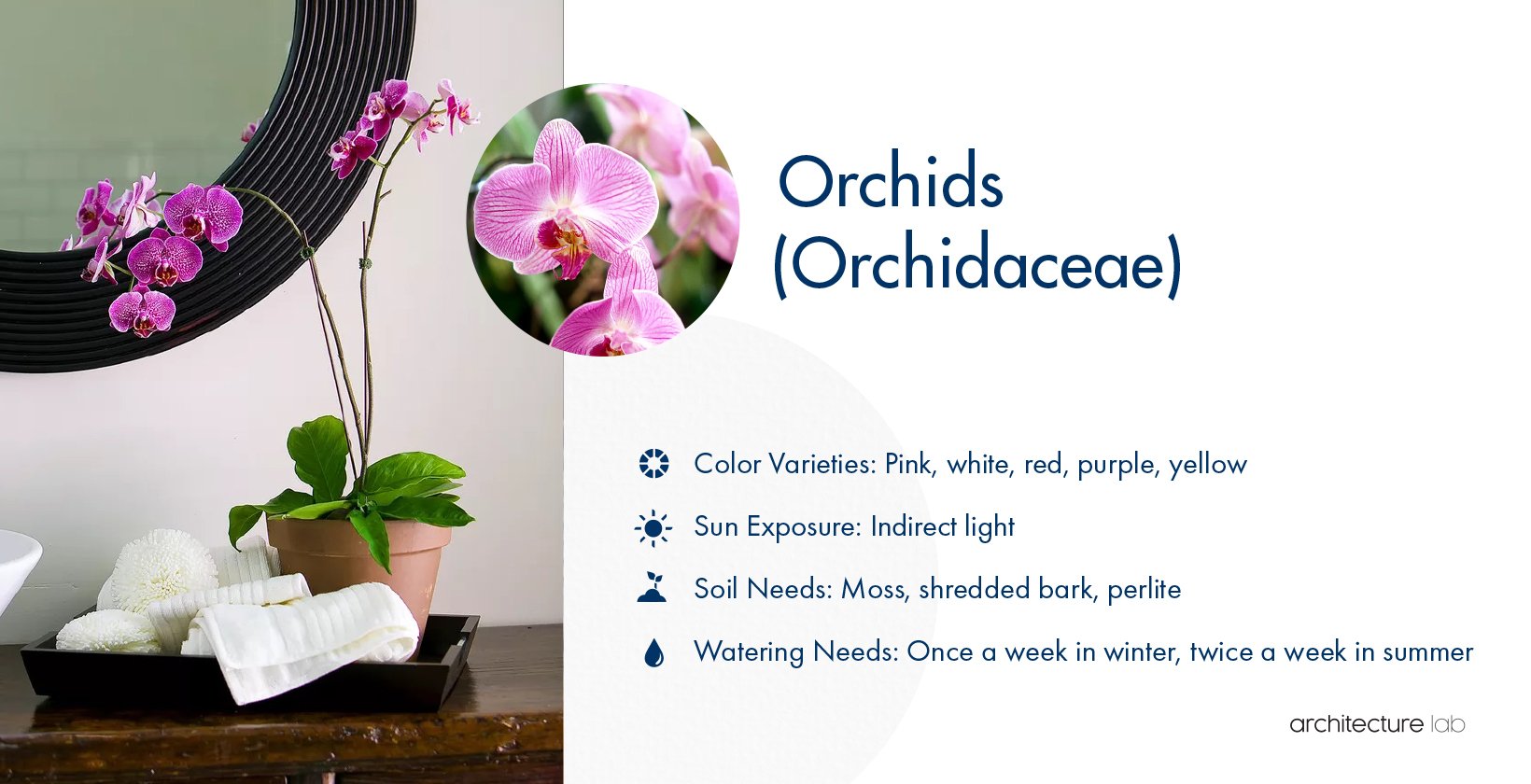
Several plant species are included under the orchid family, and they are best known for the wide range of colors in which their flowers bloom. You can find orchids bearing white, red, yellow, pink, and purple flowers. There are 17,000 to 35,000 species of orchids, and they can grow in a variety of conditions.
Orchid flowers generally have an exotic shape, with petals that may be spread wide or maybe angular. They can even be elongated and thin or ruffled. And depending on the species, they can be grown in various types of soils, like peat moss, perlite, rock wool, coconut fiber, or even a mixture of all these.
Orchids just need to be watered twice a week in summer and once a week in winter. The growing period is from summer to early fall, while flowers bloom in late fall and early winter. Most orchid species grow well in low or artificial light, and some that require very little light include Oncidium, Miltonia, and Encyclia.
Color Varieties: Pink, white, red, purple, yellow | Sun Exposure: Indirect light | Soil Needs: Moss, shredded bark, perlite | Watering Needs: Once a week in winter, twice a week in summer
3. Golden Pothos (Epipremnum aureum)
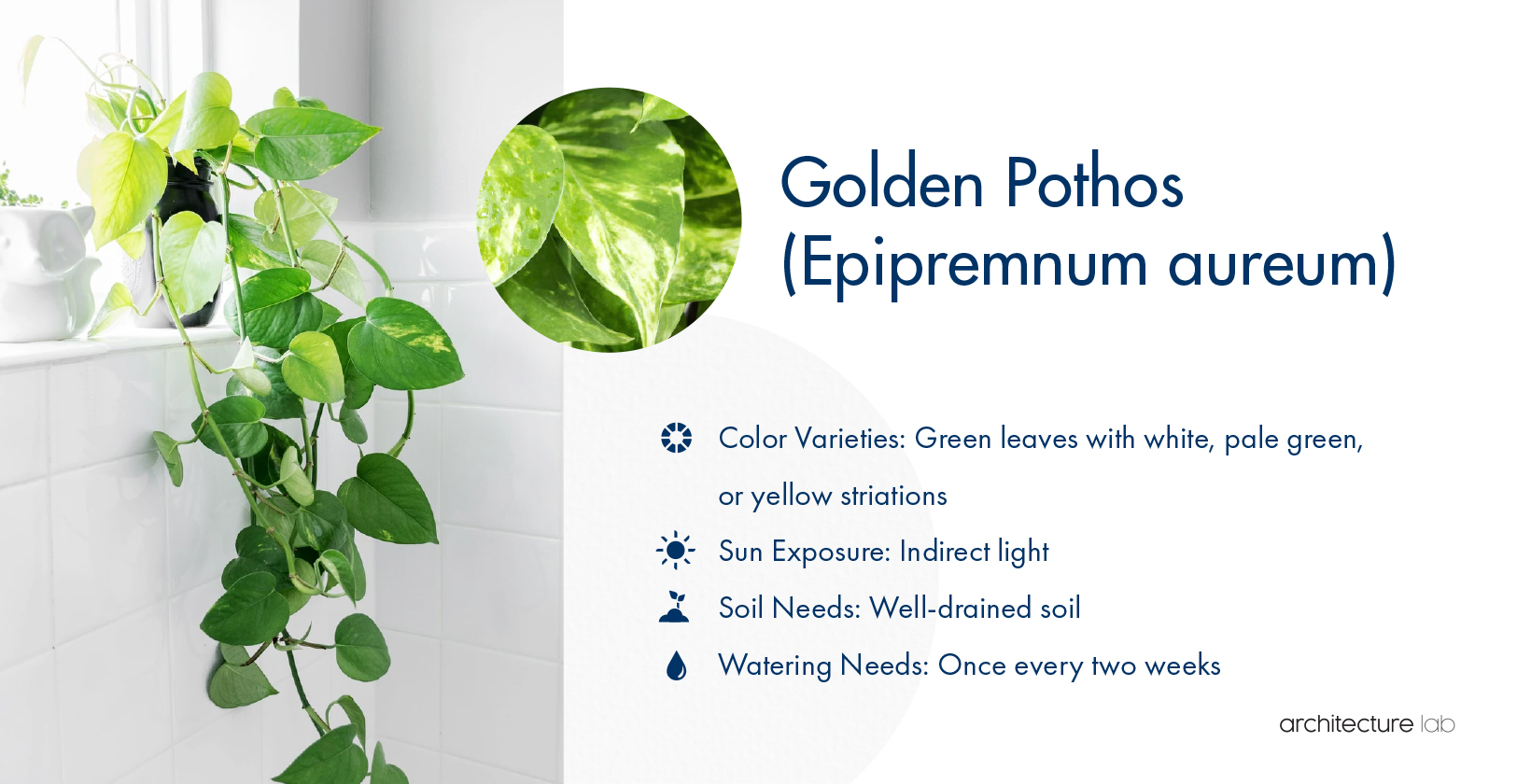
Golden pothos plants are among the most popular indoor plants since they do not require much maintenance but have a pleasing appearance. Native to the Solomon Islands in the South Pacific, this plant is also known as Devil’s Ivy and Devil’s Vine and comes in various colors and leaf sizes.
It can be easily identified by its heart-shaped leaves that are bright green and may have pale green, yellow, or white striations. The plant can adapt to a wide range of temperatures, moisture, and soil conditions, meaning you can easily place it in your bathroom.
Also, it does not require a lot of sunlight or moisture but can grow well in humid conditions as long as overwatering is avoided. Golden pothos grows quickly and can grow up to 18 inches in just one month, and a full-grown plant can grow up to 40 feet long. Being a vine, it tends to trail, which is why I find it looks great indoors.
That said, remember that pothos plants are toxic to animals, so keep your pets away from them.
Color Varieties: Green leaves with white, pale green, or yellow striations | Sun Exposure: Indirect light | Soil Needs: Well-drained soil | Watering Needs: Once every two weeks
4. Lucky Bamboo (Dracaena sanderiana)
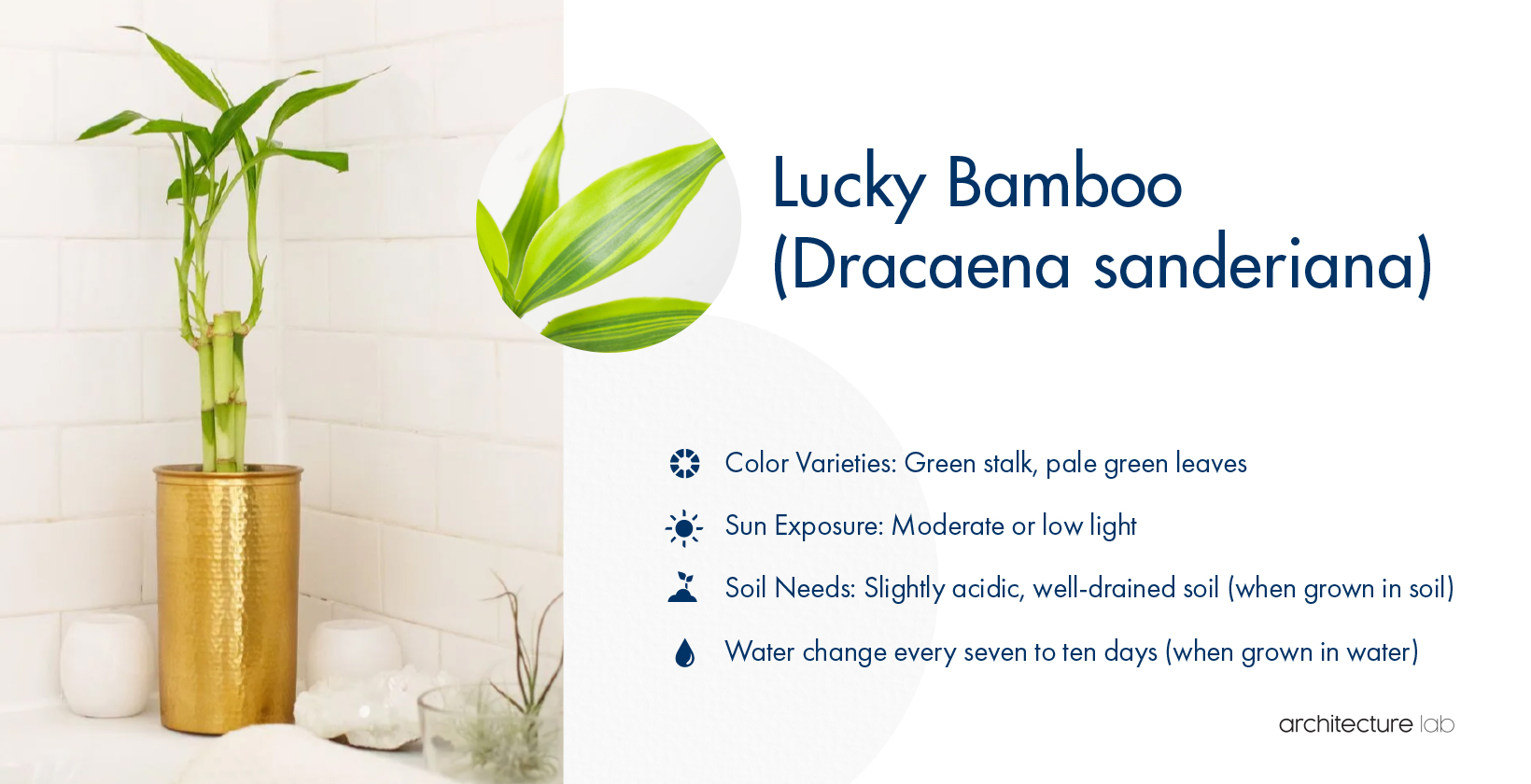
While the name Lucky Bamboo can be misleading since this plant is not a true bamboo plant, it is one of the sturdiest options on this list. Its minimalistic aesthetic makes it perfect for smaller bathrooms that have no windows. While it can flower when grown outside, this is not the case when it is kept indoors.
You can generally find lucky bamboo with three stalks that resemble real bamboo closely, with long arching slim leaves that are light green. This plant is also available in sculptural varieties, where the stalks are braided into swirls or other interesting shapes.
Lucky bamboo requires very little light to grow and can suffer if exposed to direct sunlight. Moreover, it can be grown directly in water without using soil, but the water should be changed once every few weeks. I suggest planting it in a container with marbles or pebbles with filtered water, where it can grow quite quickly.
Cat owners should note that the leaves of this plant are toxic to cats.
Color Varieties: Green stalk, pale green leaves | Sun Exposure: Moderate or low light | Soil Needs: Slightly acidic, well-drained soil (when grown in soil) | Watering Needs: Water change every seven to ten days (when grown in water)
5. Dragon Tree (Dracaena draco)
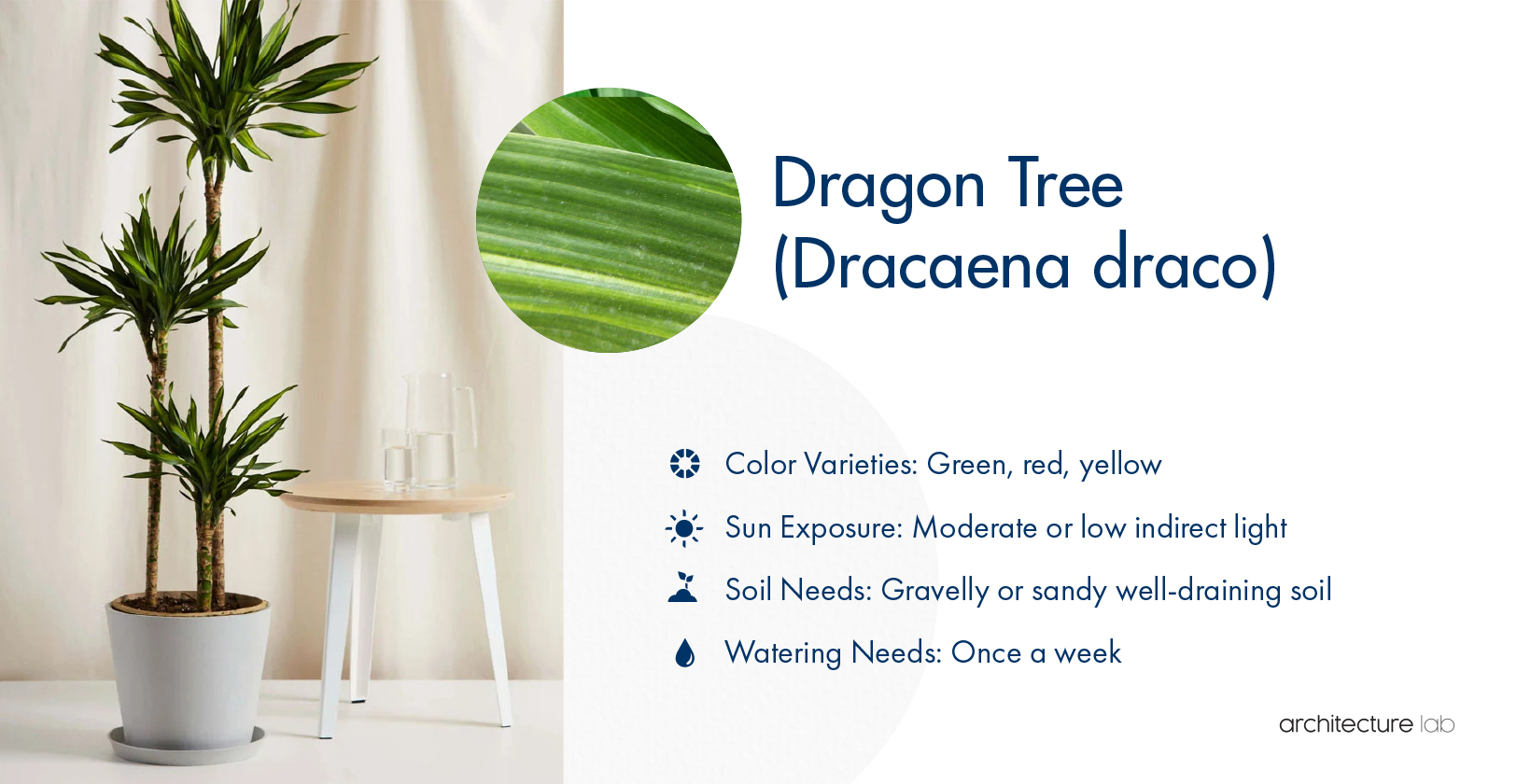
There are more than 40 varieties of the Dragon tree, which is among the most popular houseplants you can get. It has an attractive appearance, with a scaly, thick trunk and blue-green spear-like leaves. Dragon trees can also be found with variegated colorations or maroon-green options.
While it can grow up to 20 feet outside, its height is restricted indoors. Appearance aside, the dragon tree is known for its powerful air-purifying capabilities, another reason it makes such a good indoor plant.
As for growing requirements, it needs minimal light, with filtered, indirect sunlight being most suitable, along with high humidity. Because of this, it is ideal for bathrooms with very little light, and since it is a slow-growing tree, its huge height should not be a problem. In fact, it can take ten years for a dragon tree to gain four feet.
Maintenance is also easy since you just need to water the tree once a week while keeping the plant in sandy and gravelly soil.
Color Varieties: Green, red, yellow | Sun Exposure: Moderate or low indirect light | Soil Needs: Gravelly or sandy well-draining soil | Watering Needs: Once a week
6. Eternity Plant (Zamioculcas zamiifolia)
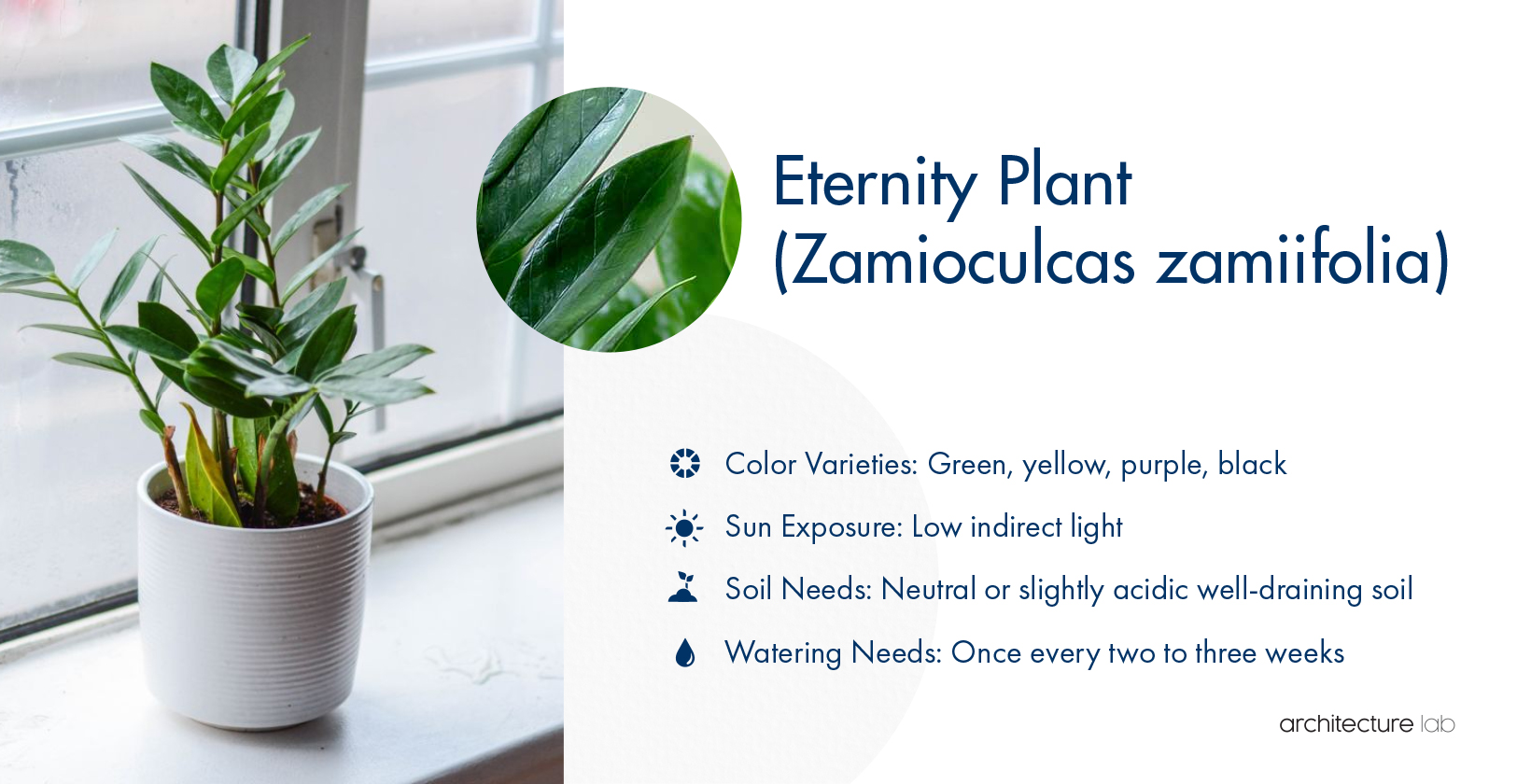
The eternity plant, often known as the ZZ plant, is a drought-resistant plant native to South Africa and very easy to care for. Like a few other options on this list, it is available in several varieties, each with a different appearance. Depending on the variety, the plant can have leaves ranging from lime green to deep purple and even black.
The leaves may also have a leathery, glossy appearance and long fronds, and the ZZ plant can grow up to three feet tall. While it can add some color to your bathroom, make sure to place it somewhere out of reach of kids and pets, as it is a toxic plant.
You can keep it somewhere where it gets medium to low natural light, such as next to a tiny shower window. Similarly, the water requirements of the eternity plant are minimal, and it only needs to be watered when the topsoil becomes dry. Another advantage is that you can use most types of potting soil to grow it.
Color Varieties: Green, yellow, purple, black | Sun Exposure: Low indirect light | Soil Needs: Neutral or slightly acidic well-draining soil | Watering Needs: Once every two to three weeks
7. Cast Iron Plant (Aspidistra elatior)
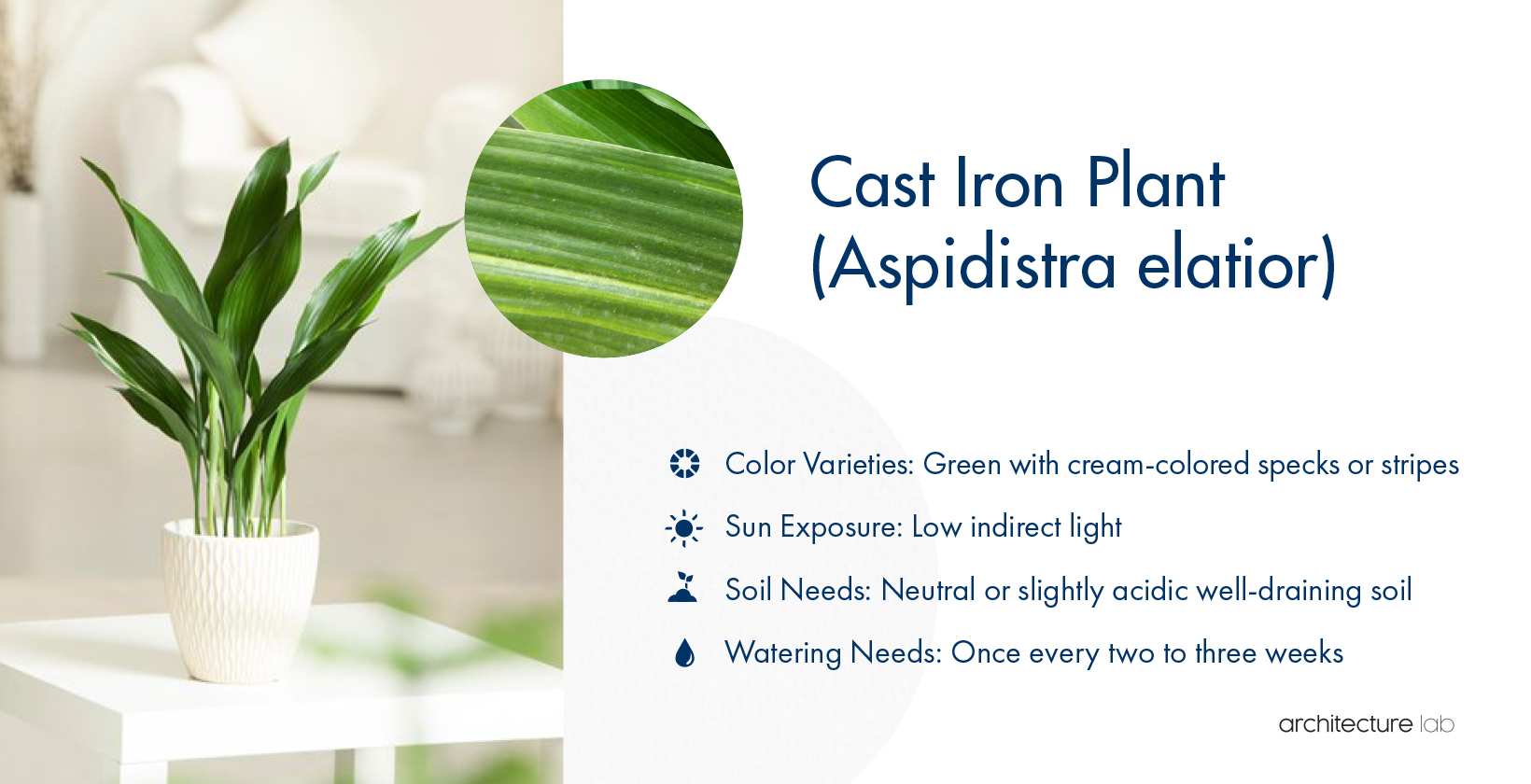
Being extremely drought-resistant and capable of surviving in very low light, the cast iron plant is another excellent indoor plant. I also like the fact that it can easily adapt to a wide range of temperatures, so temperature changes will not kill it unless they are too extreme.
Being an evergreen plant, the cast iron plant can keep your bathroom looking great throughout the year. It has long, pointed leaves with a glossy texture and may even have cream-colored spots or stripes. Bell-shaped lilac or brown-colored flowers bloom when the plant is kept outside.
The plant thrives in temperatures ranging from 50 to 85 degrees Fahrenheit, but the temperature should be consistent. As for water requirements, you can allow the soil to completely dry before watering since it is a hardy plant that does not need too much water. Avoid over-watering as that can cause water logging, leading to root rot.
Similarly, you can keep the plant away from sunlight, and it will do well even in a bathroom without windows.
Color Varieties: Green with cream-colored specks or stripes | Sun Exposure: Low indirect light | Soil Needs: Neutral or slightly acidic well-draining soil | Watering Needs: Once every two to three weeks
8. Peace Lily
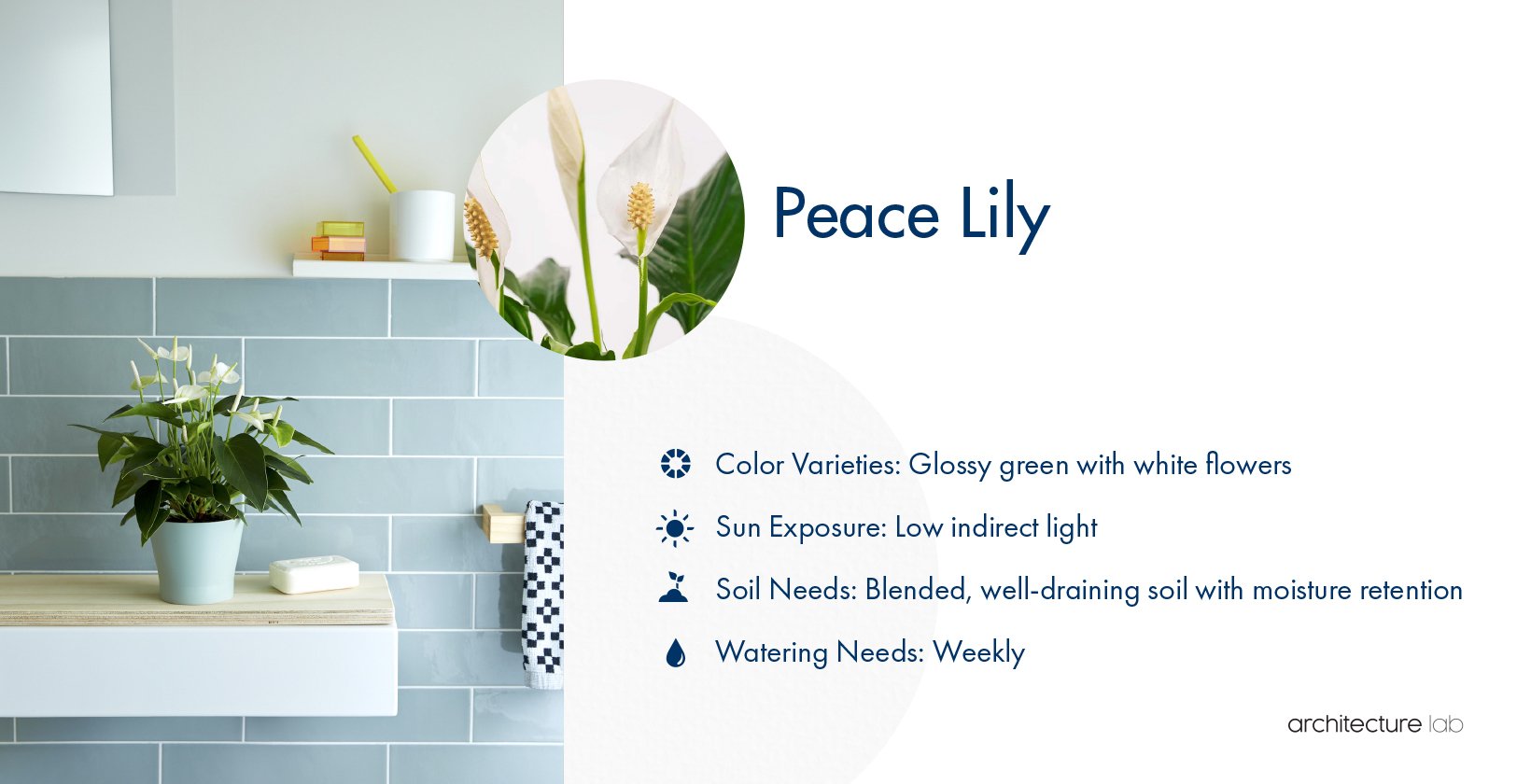
Lily plants are known for their beauty, and the peace lily is no exception. It has oval, glossy, dark green leaves that grow directly from the soil instead of the main stem and taper to a point. In addition, it can produce delicate white flowers having a very light fragrance, helping keep your shower looking and feeling fresh.
The flowers bloom twice a year when the plant is maintained properly. This means it should only be kept in an area with low, indirect light, and the soil should not become dry. But as bathrooms are generally humid and moist, these plants can be easily kept in such places.
If the soil becomes dry, the flowers will wilt quickly but can resume their normal upright position after watering. Peace lilies are also popular because they can effectively filter out harmful chemicals from the air. If you’re planning to get a peace lily for your bathroom, I suggest using blended potting soil, which drains properly but can retain moisture.
Color Varieties: Glossy green with white flowers | Sun Exposure: Low indirect light | Soil Needs: Blended, well-draining soil with moisture retention | Watering Needs: Weekly
9. Snake Plant (Dracaena trifasciata)
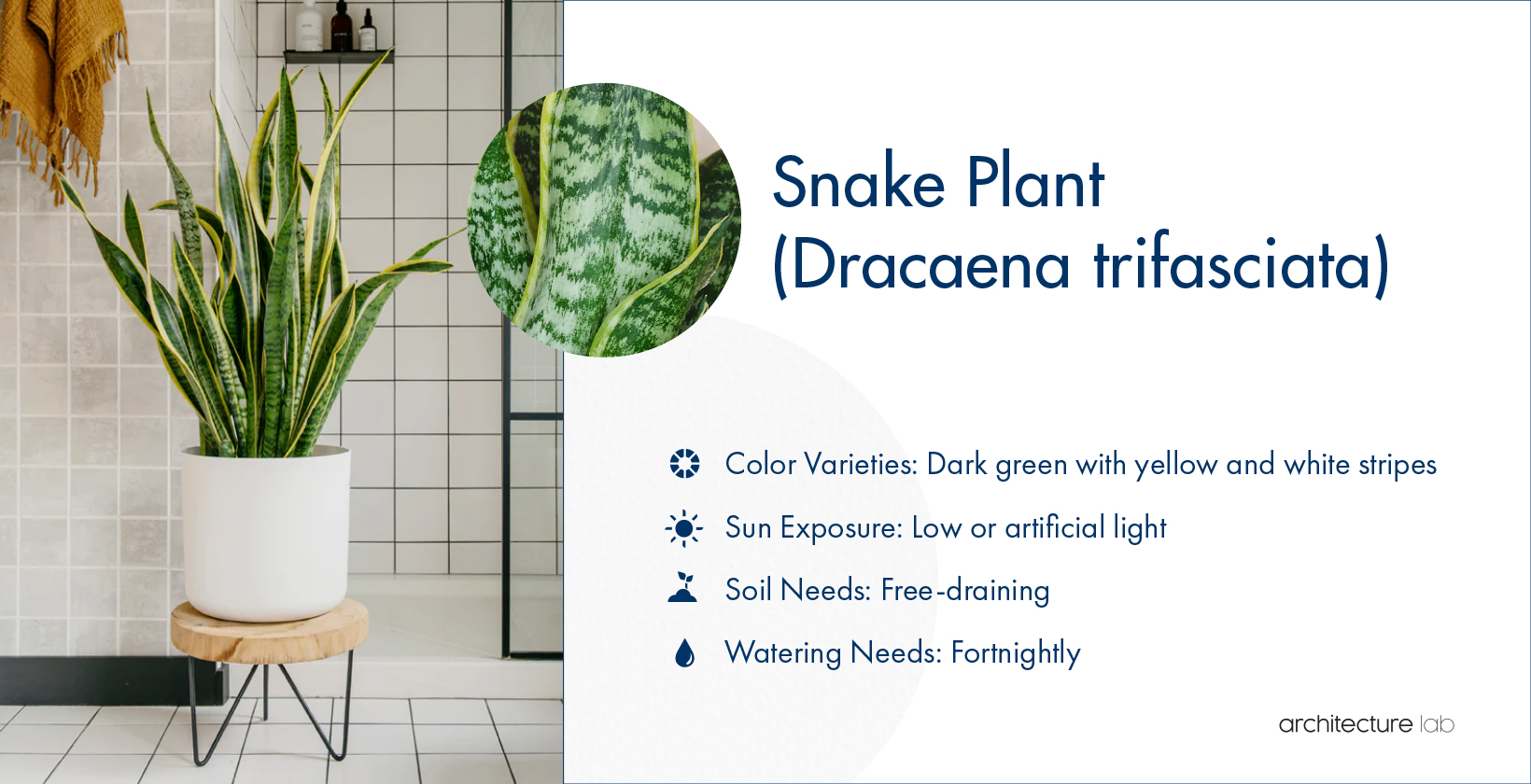
The snake plant is popular among those new to gardening and experienced pros thanks to its attractive appearance and easy care requirements. Also referred to as Mother-in-Law’s Tongue, this plant has dark green, sword-shaped leaves that grow upright and have yellow or white edges and darker stripes.
These long, vertical leaves allow the plant to be placed in areas with limited spaces, such as small bathrooms, and they can help eliminate toxins in the air. The plant does not require much looking after since it can withstand a wide range of humidity levels and does not require much light. You can place it in a shower with low indirect or even artificial lighting.
Similarly, the plant just needs to be watered fortnightly after the soil dries completely. In winter, you may only need to water the snake plant once a month. But it is highly susceptible to rot, so it should only be planted in free-draining soil that does not retain water or in a soilless potting mixture.
Color Varieties: Dark green with yellow and white stripes | Sun Exposure: Low or artificial light | Soil Needs: Free-draining | Watering Needs: Fortnightly
10. Chinese Evergreen (Aglaonema commutatum)
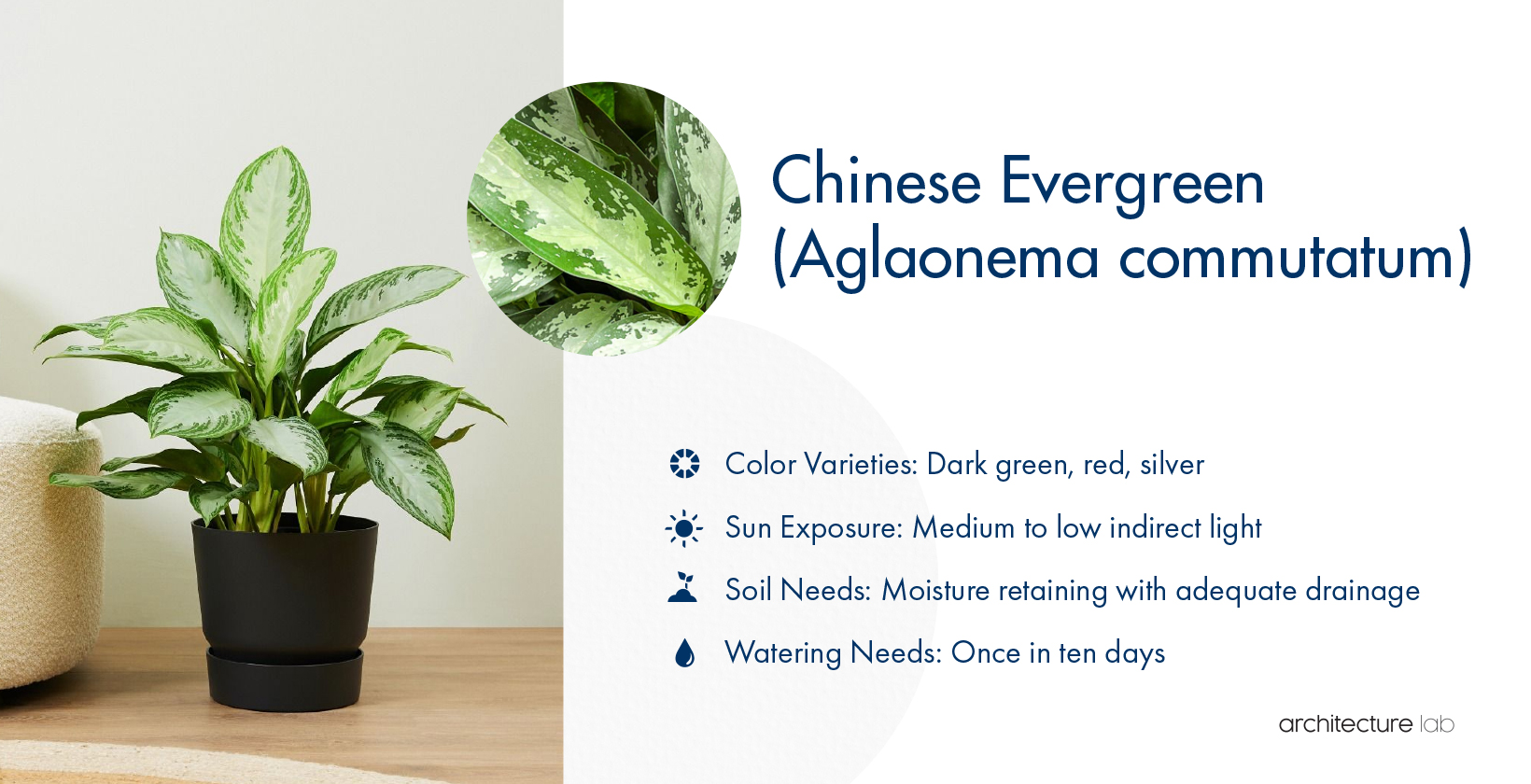
While the Chinese Evergreen plant thrives best in bright indirect sunlight, it can do well in medium to low light. It has large oval-shaped leaves that grow on short stems and have a glossy appearance. The bright green foliage, which is variegated, may have white or pink markings, and the bold patterns and bright colors make it perfect for various settings.
This plant can often be seen in malls and offices since it does not require much care but can help make such spaces more aesthetically pleasing. It likes higher humidity levels, making it perfect for use as a bathroom plant. When placed indoors, the Chinese evergreen can grow up to three feet tall.
It can grow six to 12 inches a year, with most growth taking place during the warmer months. However, since it is a slow grower, it will take four to six years for the plant to reach its full height. The plant requires soil that prevents water logging but can retain some amount of water.
Color Varieties: Dark green, red, silver | Sun Exposure: Medium to low indirect light | Soil Needs: Moisture retaining with adequate drainage | Watering Needs: Once in ten days
11. Air Plants
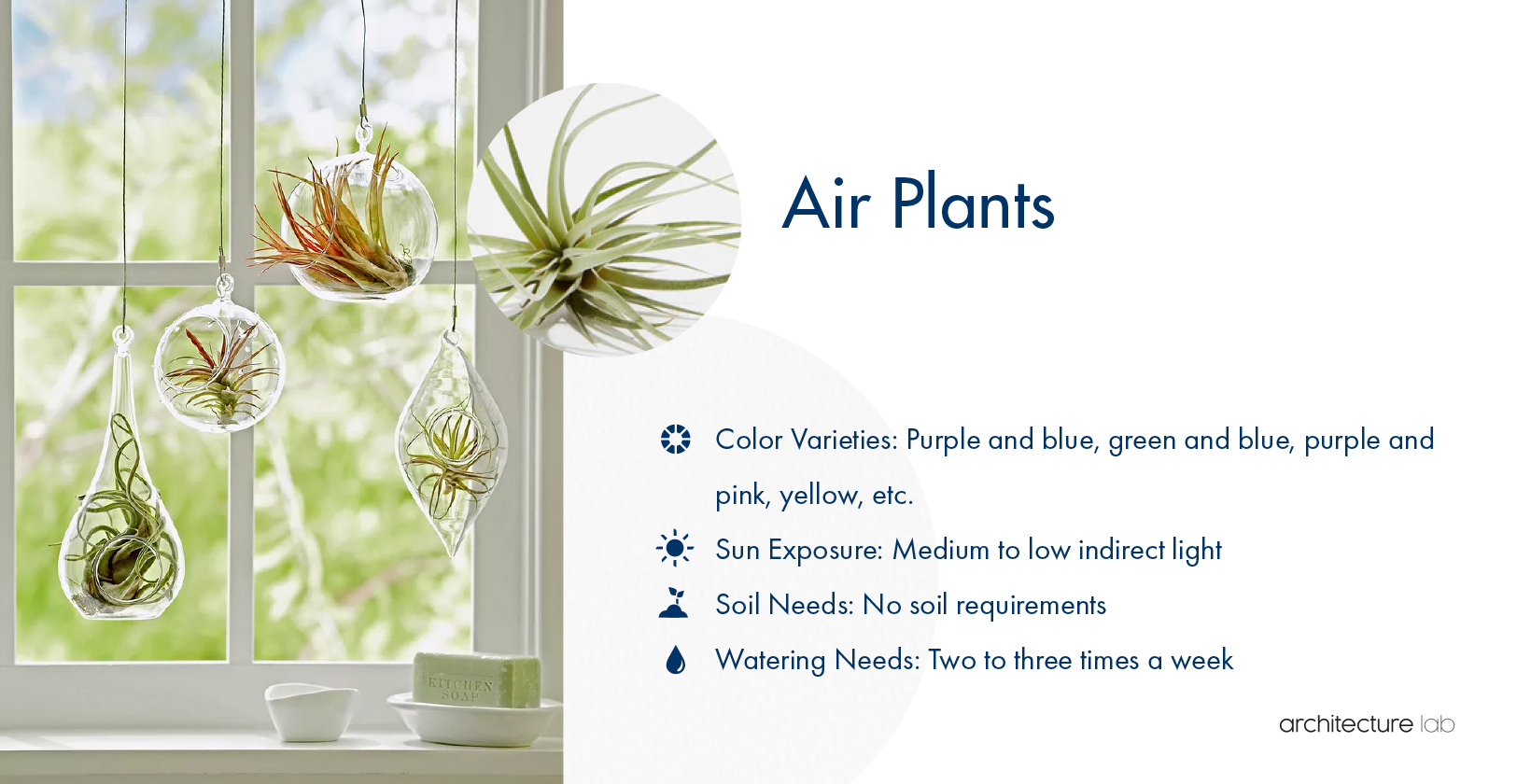
Air plants are tropical plants that include several species, epiphytes being the most common. In their natural habitat, these moisture-loving plants grow on tree branches and absorb moisture from the air. This means that you do not require to plant them in soil, and they can be grown directly in water.
Different types of air plants can vary in their appearance considerably. Some, such as tillandsias, have stiff, thin leaves with scaly surfaces. The leaves may grow from a rosette in the center of the plant and may be fuzzy and spiky and range from green to silver in color. Some air plants produce purple, pink, or red flowers.
They are also non-toxic, which makes them suitable for homes with children and pets, and they do not require much care since a potting mix is not required. But these plants require a lot of water, so watering them two to three times a week is ideal. Also, they can grow easily in moderate to low lighting conditions.
Color Varieties: Purple and blue, green and blue, purple and pink, yellow, etc. | Sun Exposure: Medium to low indirect light | Soil Needs: No soil requirements | Watering Needs: Two to three times a week
12. Spider Plant (Chlorophytum comosum)
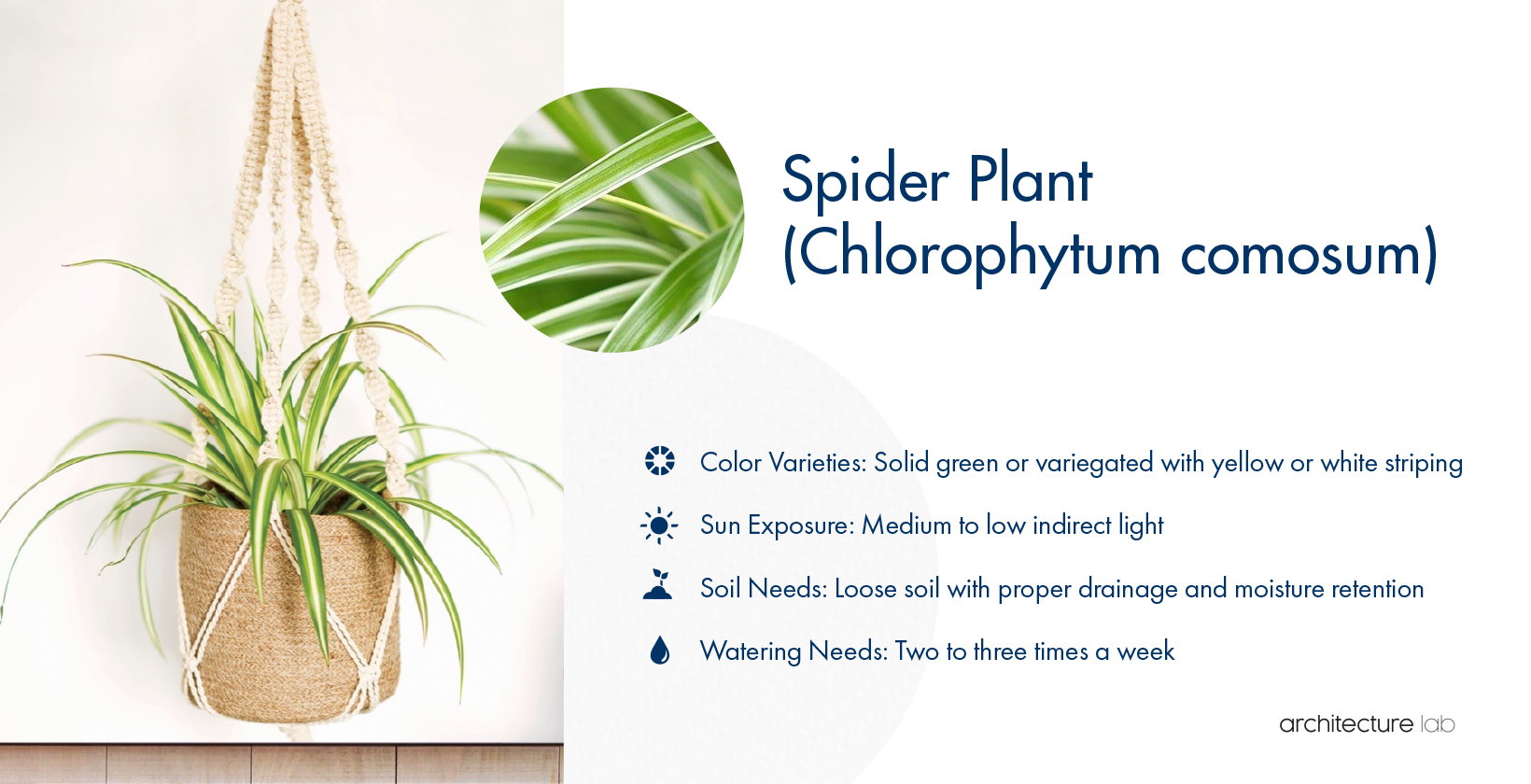
Another excellent option among indoor plants that can help purify the air is the spider plant. Native to South Africa, the spider plant is a perennial plant with strap-shaped, narrow leaves growing from the center. This plant is known to be capable of removing harmful substances like formaldehyde from the air and is very easy to care for.
Its leaves can be solid or light green or maybe variegated with yellow or white stripes and can appear folded from the middle. Spider plants grow quickly and can outgrow their pots if not repotted or replanted every other year. They grow 12 to 15 inches every six to 12 months, attaining a maximum height of 24 inches.
These plants can grow in all lighting conditions, from bright to moderate indirect and even low light, and can go for long periods without water. Unlike most other plants, however, spider plants propagate by developing off-shoots called spiderettes, which can be removed from the main plant and grown separately.
Color Varieties: Solid green or variegated with yellow or white striping | Sun Exposure: Medium to low indirect light | Soil Needs: Loose soil with proper drainage and moisture retention | Watering Needs: Two to three times a week
13. Aloe Vera (Aloe barbadensis miller)
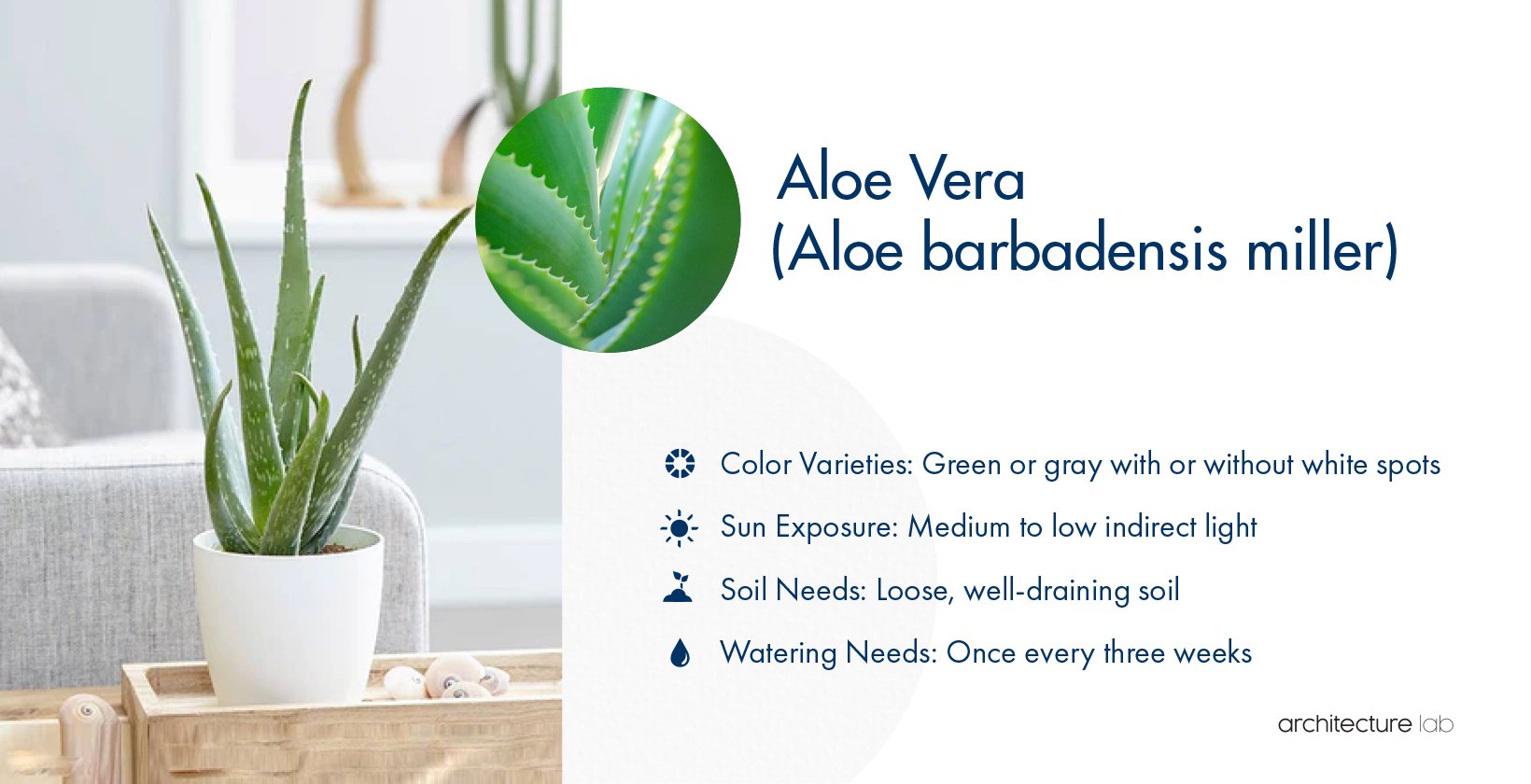
You may be familiar with the healing properties of the Aloe plant, but what you may not know is that it is one of the toughest plants on the planet. Being a succulent, it can retain water in its thick, fleshy parts, which enables it to endure even the harshest conditions easily. While there are several aloe plant varieties, the one generally associated with medicinal properties is aloe vera.
The succulent leaves of the aloe plant are arranged in the form of a rosette, and their color can range from green to gray, sometimes with white spots. Pinkish, sharp spines lie along the edges of the leaves and produce the gel for which this plant is known. While the aloe plant prefers bright sunlight, its growth isn’t affected by low light conditions.
Additionally, it has meager water requirements and can even survive on the humidity in your bathroom alone, though it is best to water it occasionally. And like most other plants I’ve mentioned here, it needs well-draining soil.
Color Varieties: Green or gray with or without white spots | Sun Exposure: Medium to low indirect light | Soil Needs: Loose, well-draining soil | Watering Needs: Once every three weeks
14. Peperomia Plant (Peperomia obtusifolia)
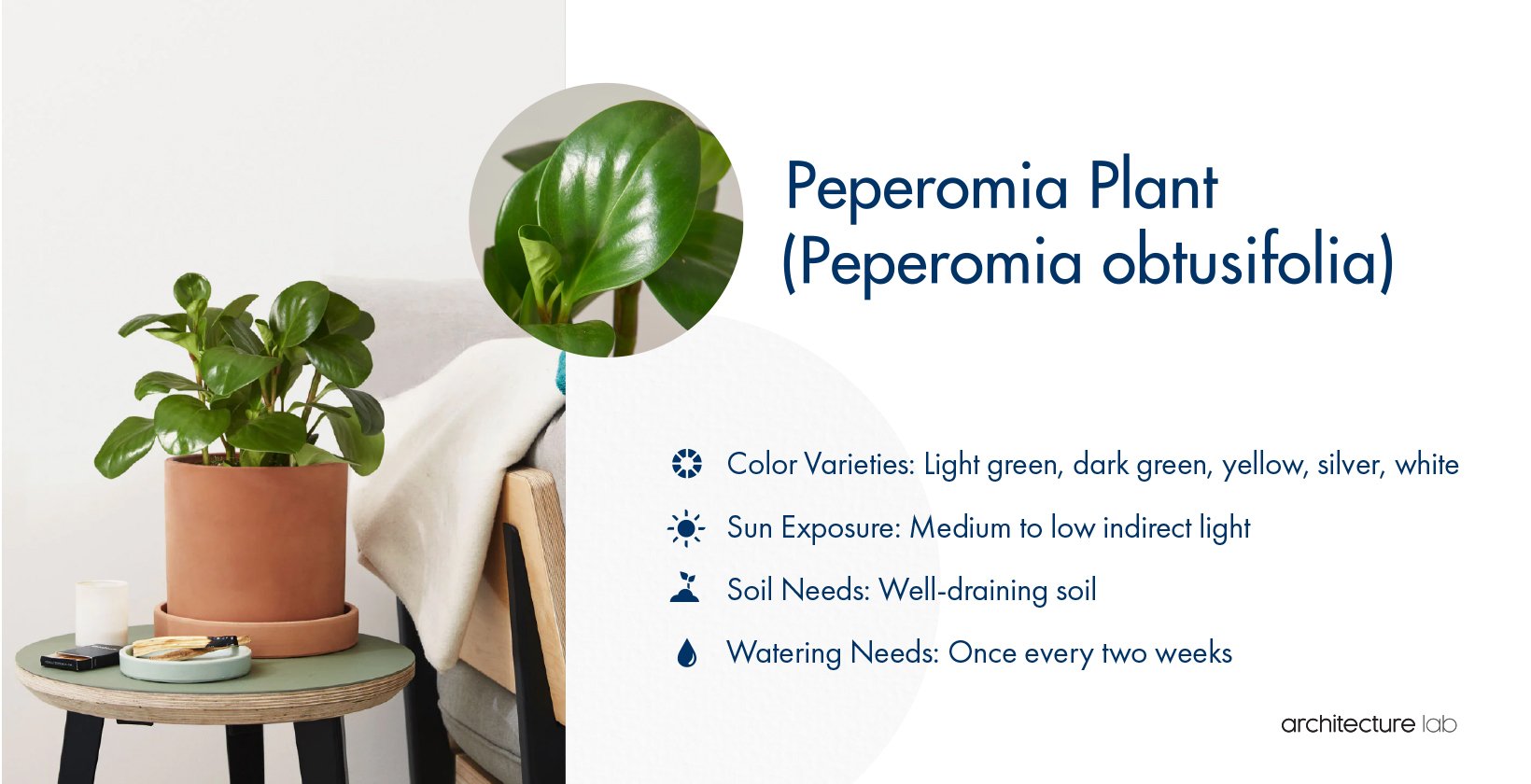
The most striking feature of the peperomia plant is its leaves which are generally colored and striped like a watermelon. But several varieties of this plant are available, with different leaf shapes and colors. The plant is compact, making it perfect for tight spaces like tiny bathrooms, which is why it is a popular houseplant.
Peperomia plants do not require much light and can grow well in artificial light. Light misting easily meets their humidity requirements, but the plants should not be overwatered. That is also why they need well-draining soil that should not get waterlogged. When provided with optimal growing conditions, peperomia can grow quickly, gaining three to four feet of length in a year.
But the plant is highly susceptible to root rot and can be damaged by mealybugs. Severe infestations can cause the plant to die, but this can be prevented by treating the plant with Isopropyl alcohol. It is also a non-toxic plant, which makes it a safe option for homes with pets.
Color Varieties: Light green, dark green, yellow, silver, white | Sun Exposure: Medium to low indirect light | Soil Needs: Well-draining soil | Watering Needs: Once every two weeks
15. Philodendrons (Philodendron)
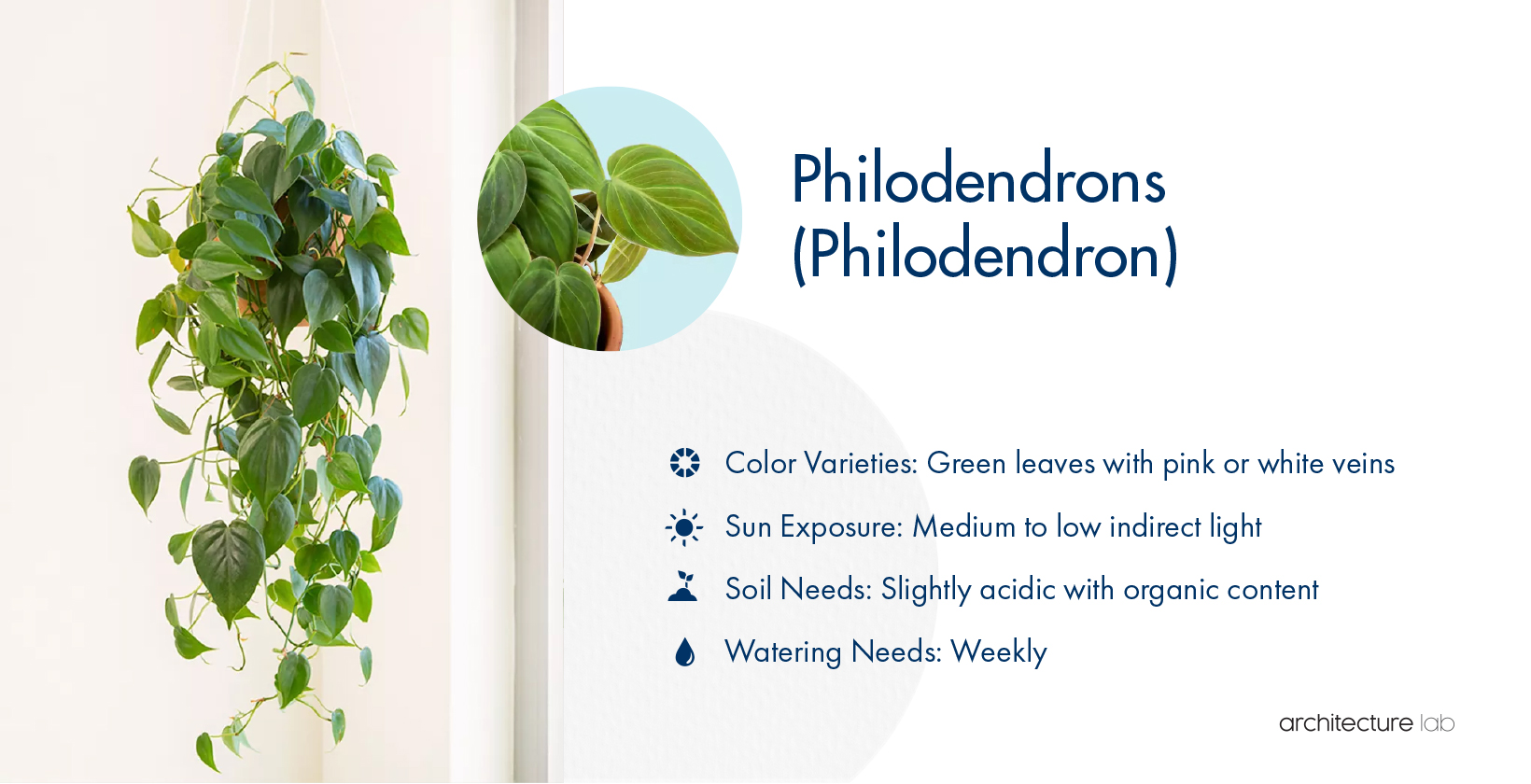
While several varieties of the philodendron plant, native to the West Indies and tropical America, are available, the most popular is the heartleaf philodendron. It is sometimes confused with the pothos plant due to its similar appearance, but its heart-shaped leaves help distinguish it.
Many varieties of the plant have glossy green leaves, but you can even find philodendrons with purple, red, or coppery leaves. The leaves may also be variegated or split along the center, which is the case with the Montera variety of philodendrons. Since it is a trailing plant, it can be placed on a shelf or windowsill.
Philodendrons also help purify the air by removing contaminants like xylene and formaldehyde, but they are toxic plants, so make sure to place them somewhere away from pets and children. You can keep it somewhere with medium to low light conditions, though the plant grows best in bright indirect light. Watering should also be done once a week after letting the soil dry out completely.
Color Varieties: Green leaves with pink or white veins | Sun Exposure: Medium to low indirect light | Soil Needs: Slightly acidic with organic content | Watering Needs: Weekly
16. English Ivy (Hedera Helix)
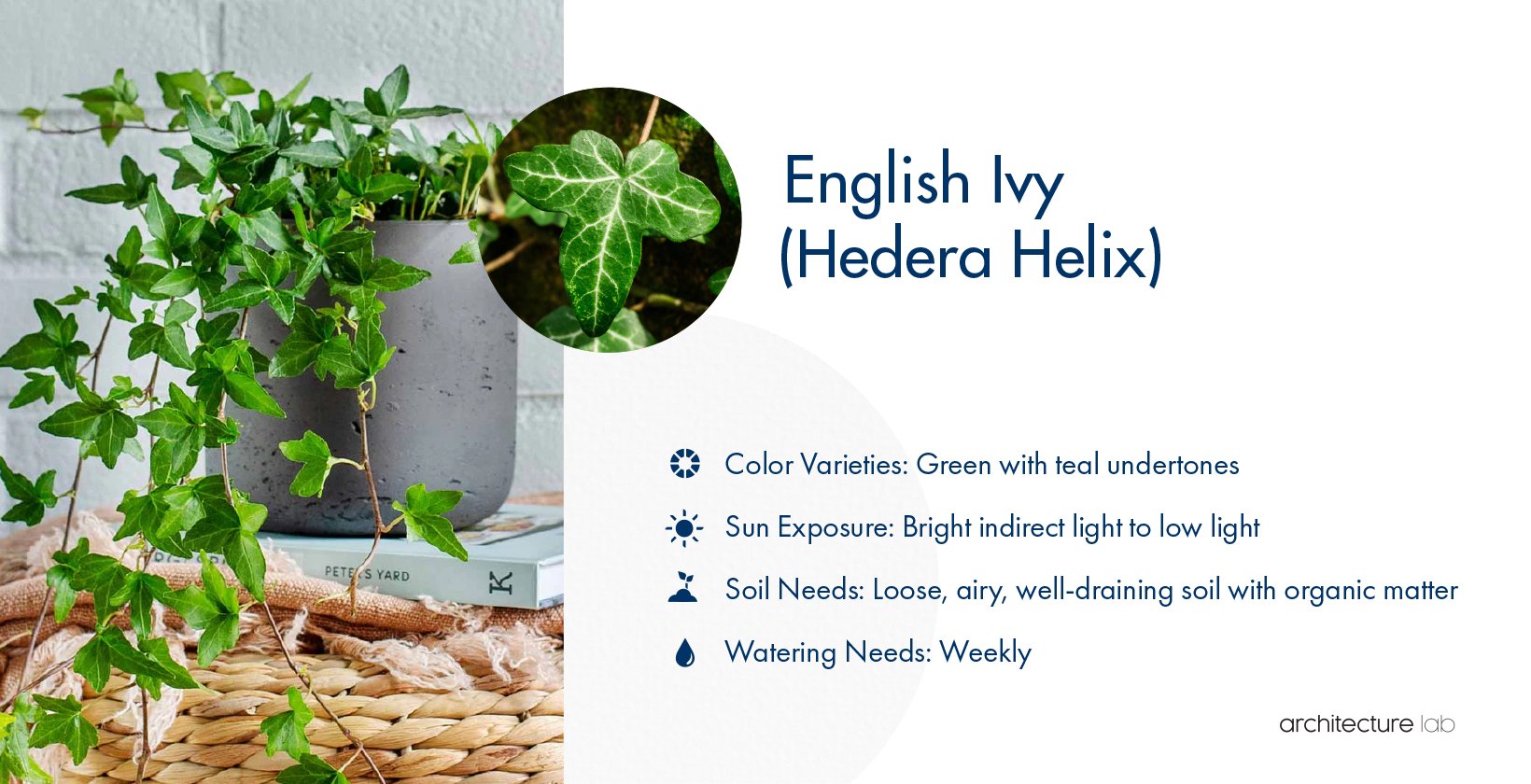
Almost every type of ivy plant is effective in eliminating air contaminants, and English Ivy is among the best ones. The plant has dark leaves with light-colored veins and may have a leathery or waxy appearance. It is known to be capable of removing mold spores from the surrounding air and can be grown in hanging baskets in areas with low light.
English ivy can easily cope with low light levels, though variegated forms tend to turn completely green in the absence of bright light. These leaves can grow in various forms and may have three to five lobes or be unlobed. Being a climber, this ivy can cling to shelves and window sills of your shower, adding to the aesthetics.
Also, like other ivy varieties, the English ivy should not be overwatered, and the humidity in bathrooms provides them with ample moisture. You should only water it when a few inches of the topsoil become completely dry, or alternatively, grow it in water without using soil.
Color Varieties: Green with teal undertones | Sun Exposure: Bright indirect light to low light | Soil Needs: Loose, airy, well-draining soil with organic matter | Watering Needs: Weekly
17. Boston Fern (Nephrolepis Exaltata)
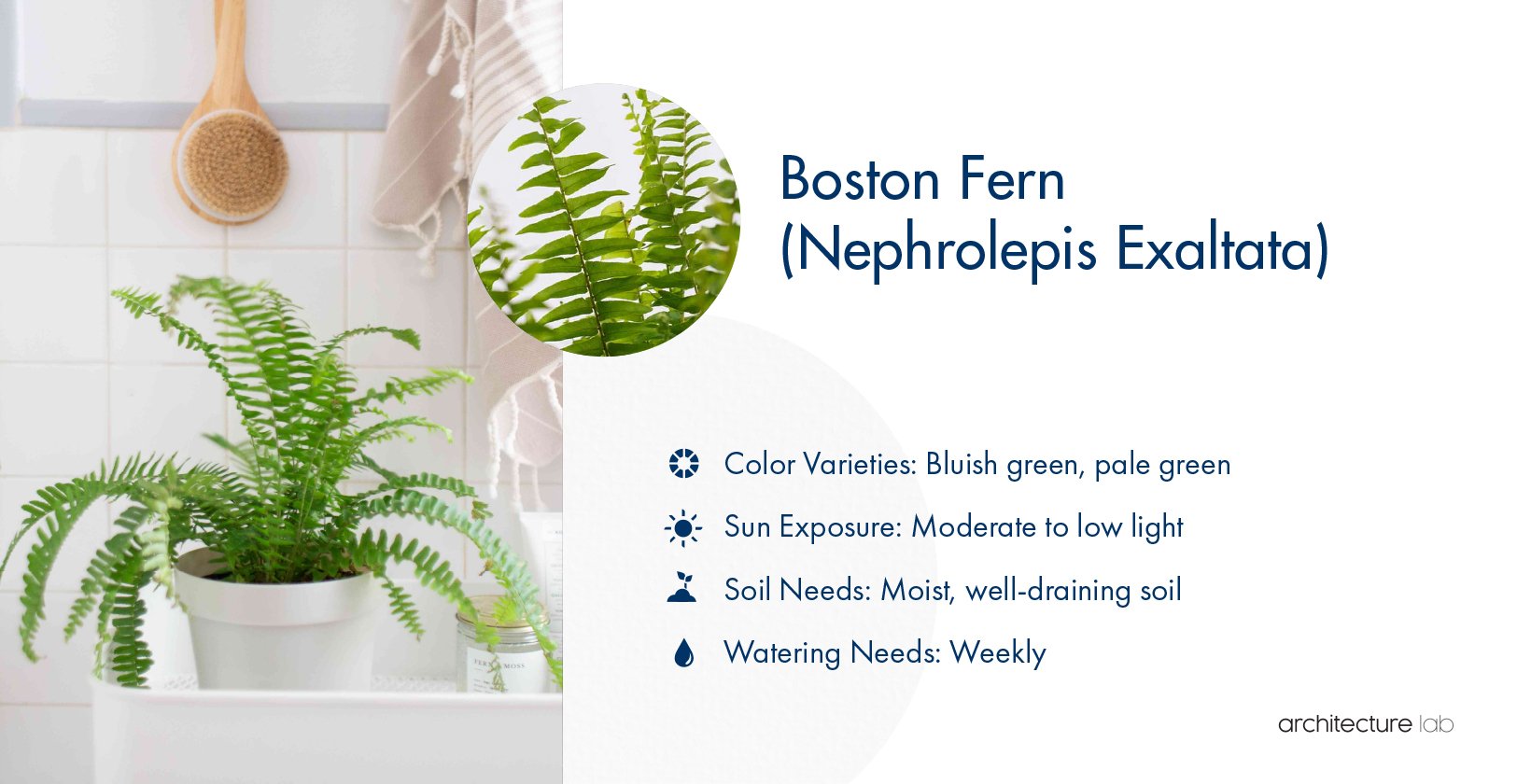
Many types of ferns are used as indoor plants, and the Boston fern is an especially popular option since it helps purify the air by removing contaminants like formaldehyde. Additionally, this fern can restore moisture to the air, which is very handy in dry seasons and can help prevent dry throats and skin.
The plant has medium to pale green fronds that can achieve a width of six feet and a length of four feet. Like other ferns, these do not produce seeds but produce spores for propagation. When younger, the sword-shaped fronds with small leaflets are erect but start drooping as the plant ages. This gives it a ruffled appearance that can enhance the beauty of your bathroom.
They can do well in shaded bathrooms with low light, so keep them out of direct bright sunlight. Boston ferns also require a lot of moisture, which means that a shower can be a good place to keep them where the humidity is high.
Color Varieties: Bluish green, pale green | Sun Exposure: Moderate to low light | Soil Needs: Moist, well-draining soil | Watering Needs: Weekly
18. Majesty Palm or Parlor Palm (Chamaedorea elegans)
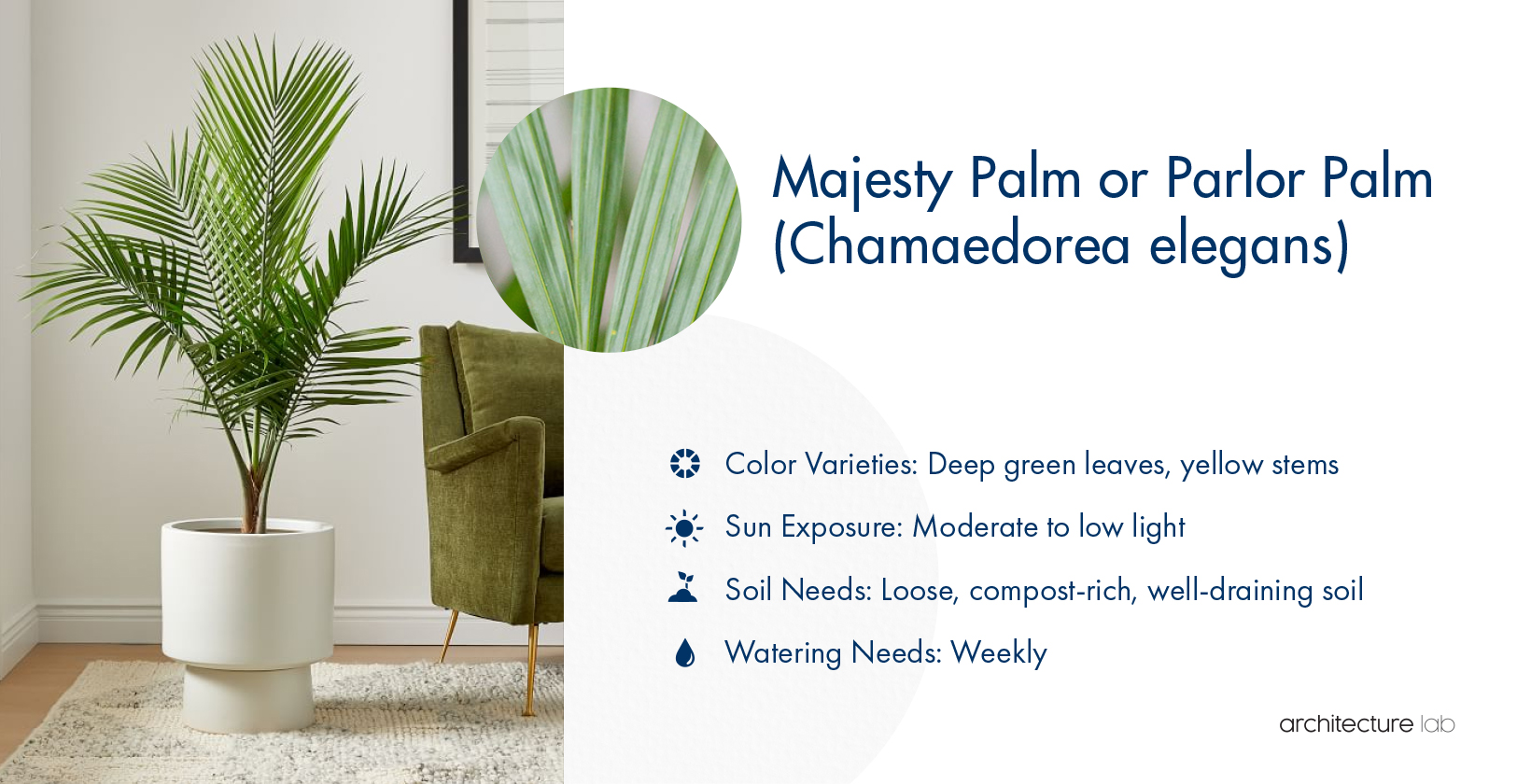
The Majesty or Parlor palm might be a suitable option for those with considerable room in their shower. These have yellowish, slender stems carrying delicate fronds that grow in clusters. The leaves are deep green, providing an elegant appearance that can help brighten your shower.
Parlor palms love moisture, so hot and humid bathrooms are well-suited for these plants. They also thrive in low light conditions, and prolonged exposure to bright sunlight can lead to scorching of the leaves. Since the plants require adequate water, you need to water them at least once a week. At higher temperatures, this may go up to twice a week.
These palms can be grown in loose, well-draining soil that may be mixed with compost and grow quite slowly. While they can reach up to 16 feet outdoors, their height usually does not exceed six feet when grown indoors.
That said, the parlor palm only grows a few inches a year and is highly susceptible to diseases and pests, like stem cankers and fungal leaf spots.
Color Varieties: Deep green leaves, yellow stems | Sun Exposure: Moderate to low light | Soil Needs: Loose, compost-rich, well-draining soil | Watering Needs: Weekly
19. Calathea
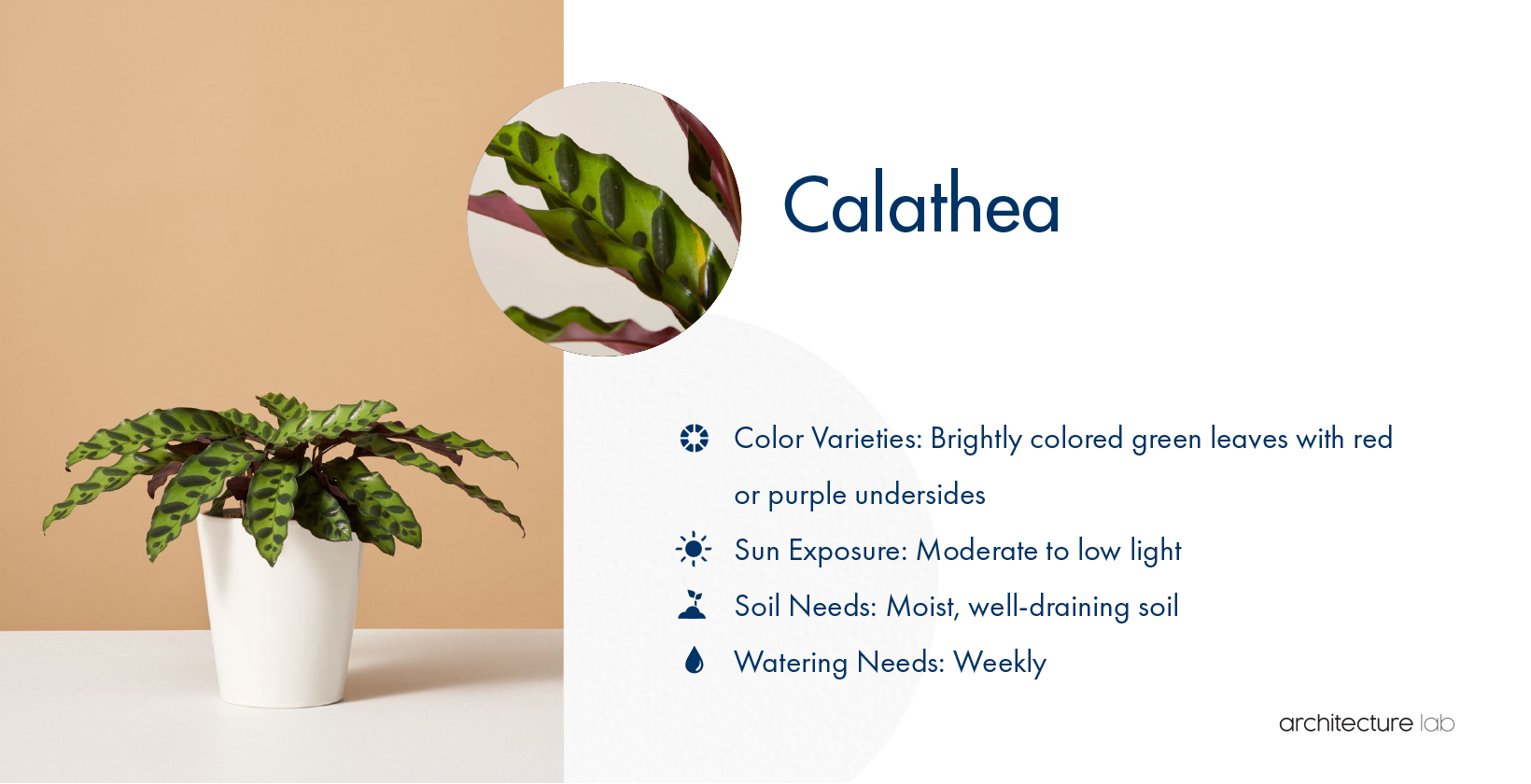
The calathea plant is another option that works great indoors in areas with medium to low light levels. It looks pretty attractive, and there are various varieties of the plant you can choose from. The most common variety has dark green, luscious leaves with a burgundy-purple hue and generally has intricate patterns that almost look artificially painted.
Calathea plants should be kept away from direct bright sunlight, which is why they are perfect for low-lit bathrooms. These plants grow best in moist soil, provided that it drains well; otherwise, they may be afflicted with root rot. They only need to be watered once a week, even less if the topsoil remains wet, so caring for them is easy.
Calatheas grow moderately and have a maximum height of two feet, which they can attain within a year. Additionally, gravel and pieces of orchid bark can help the root develop faster. The ideal temperature range for a calathea plant is between 65 and 85 degrees Fahrenheit, and this plant is non-toxic and non-poisonous.
Color Varieties: Brightly colored green leaves with red or purple undersides | Sun Exposure: Moderate to low light | Soil Needs: Moist, well-draining soil | Watering Needs: Weekly
20. Fiddle Leaf Fig (Ficus lyrata)
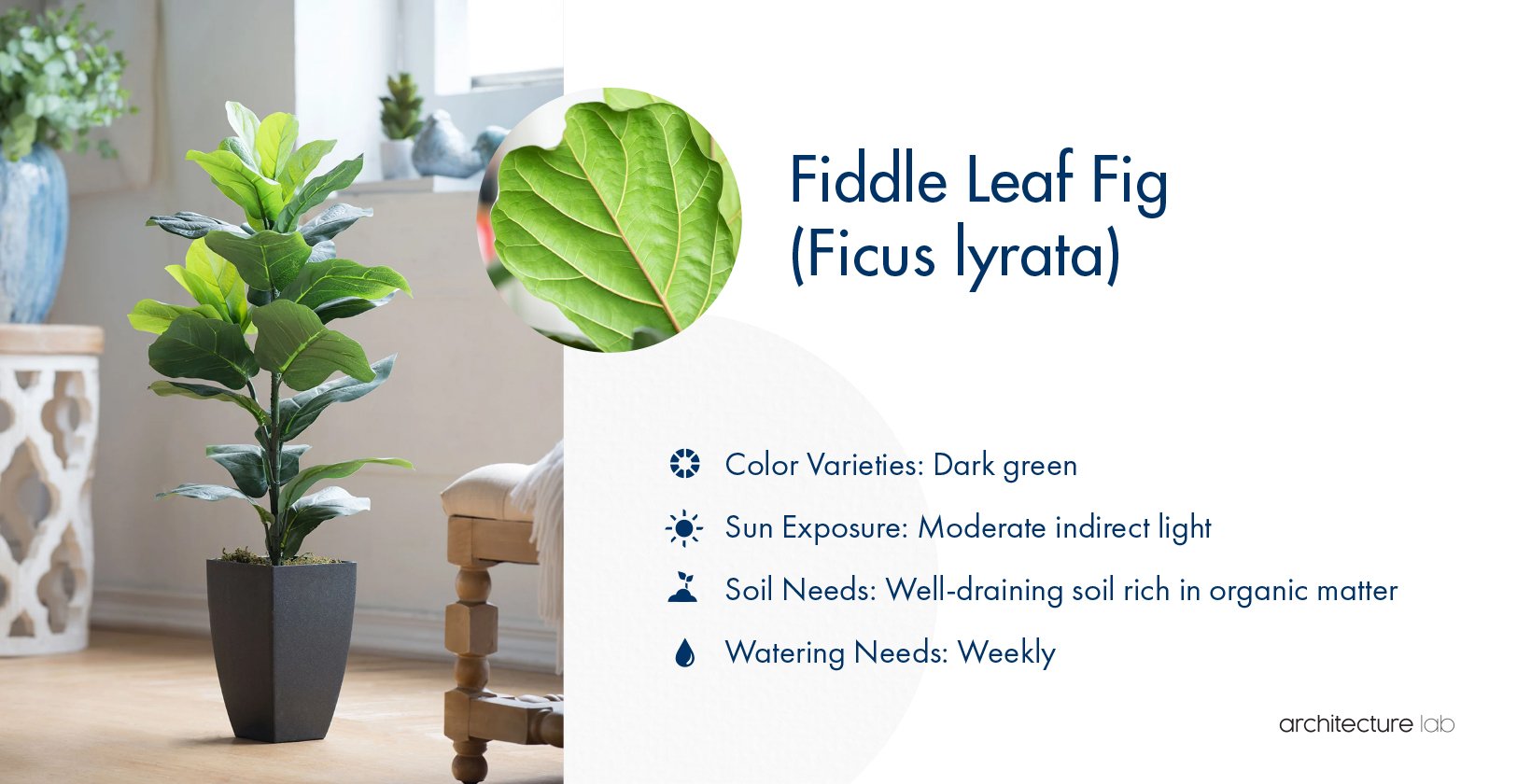
Fiddle leaf figs are another great option for large-sized bathrooms and can help you make a bold statement. These are large evergreen trees with glossy, fiddle-shaped leaves that provide bushy foliage. The leaves also have a prominent stem and thick veins.
This plant likes indirect sun that is not too strong, so it can be kept in the shower. It can also handle above-average temperatures, which is usually the case in bathrooms, especially after a long shower. Just make sure to water it once a week after checking that the soil has become dry, and avoid overwatering.
Fiddle leaf figs grow best in soil that drains well and is rich in organic matter, such as peat-based soil. However, if you plan to install this plant in the bathroom, keep it out of reach of pets and children, as it is toxic.
Bacterial infections are common in fiddle leaf figs, and treatment requires repotting the plant, allowing it to dry, and giving it some sun.
Color Varieties: Dark green | Sun Exposure: Moderate indirect light | Soil Needs: Well-draining soil rich in organic matter | Watering Needs: Weekly
21. Kangaroo Fern (Microsorum pustulatum)
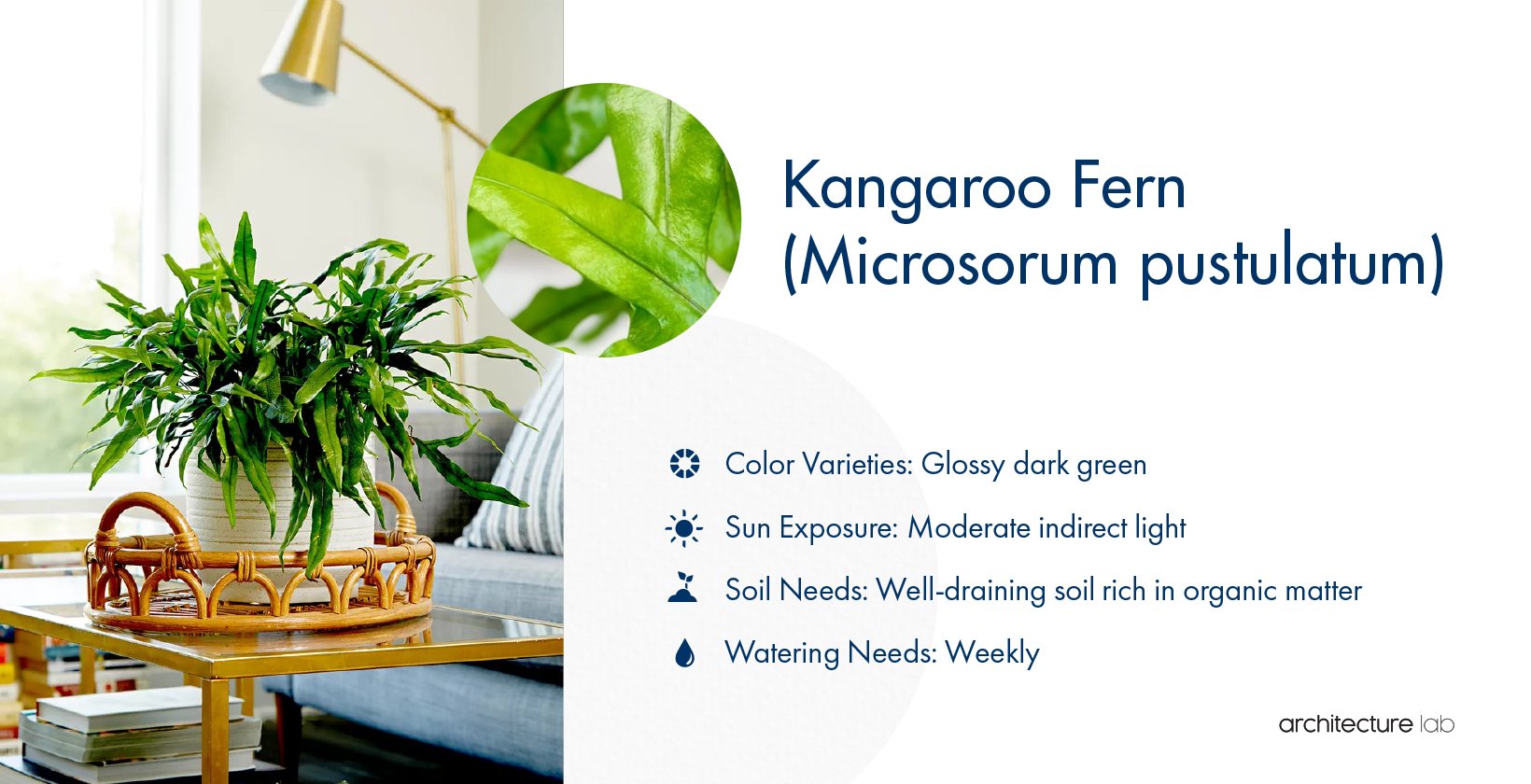
Like other ferns, the kangaroo fern likes a lot of humidity, making it an ideal bathroom plant. But it has much tougher and more leathery foliage, making it more hardy and easier to care for. The leaves are deep green, glossy and grow on thin, long stems.
While this plant likes bright to moderate indirect light, it can cope well with low-light conditions. Humidity levels should be high where the plant is kept, and the soil should be moist but not soggy. So, you should provide it with enough water regularly after the topsoil becomes dry.
This plant grows well in soil that drains quickly but contains a lot of organic matter and can reach its full size in two years. I’ve also found adding coco coir and peat moss to the pot in which it is growing to be helpful. The ideal temperature range for this plant is 60 to 70 degrees Fahrenheit, but it can tolerate temperatures as low as 50 degrees and as high as 75 degrees.
Color Varieties: Glossy dark green | Sun Exposure: Moderate indirect light | Soil Needs: Well-draining soil rich in organic matter | Watering Needs: Weekly
22. Pilea Plant (Pilea peperomioides)
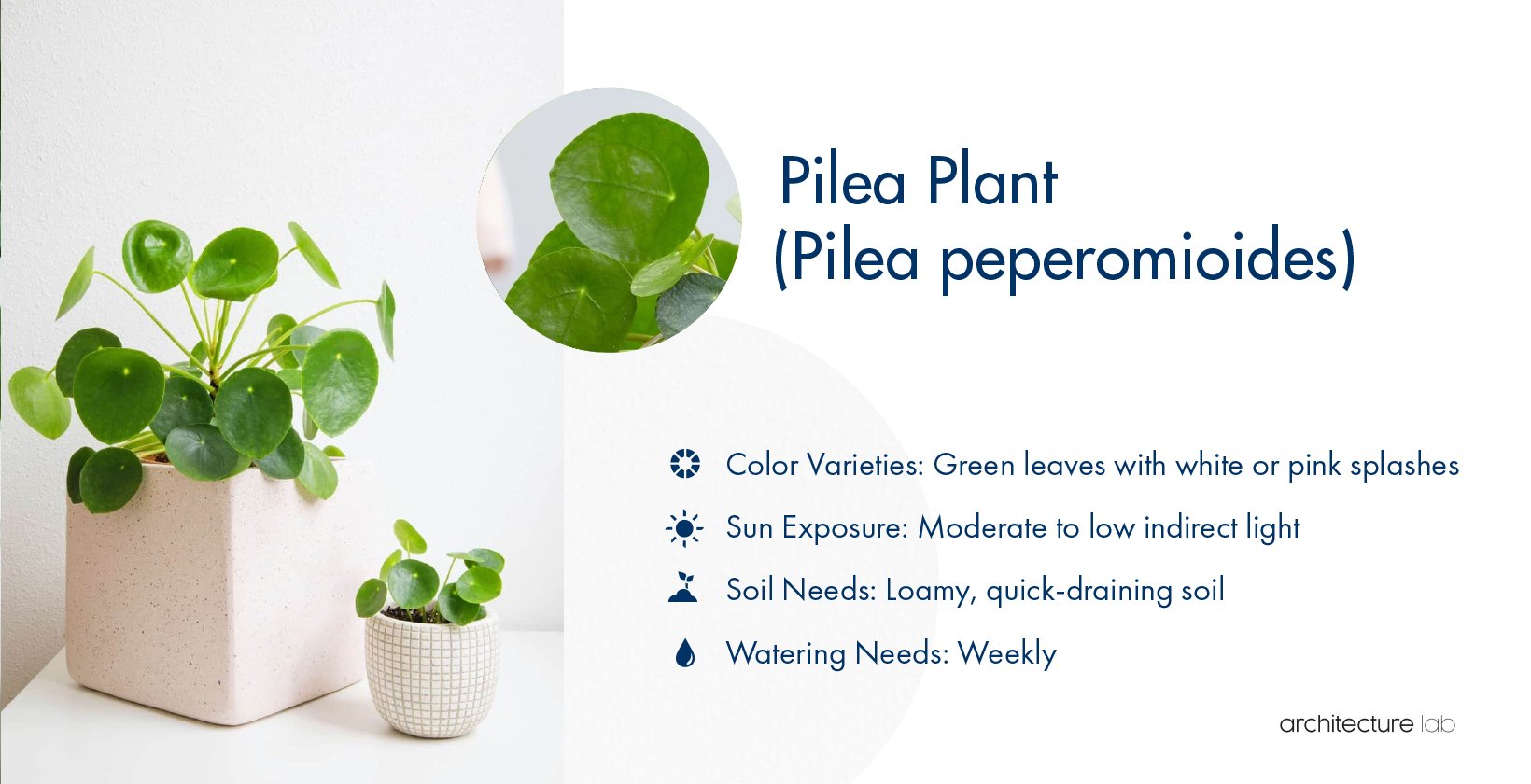
Also known as the Chinese money plant, the pilea plant is a popular indoor plant due to its bright and attractive appearance, with uniquely shaped leaves and small size. It is an evergreen plant with dark green, shiny, round-shaped leaves that help it stand out among indoor plants. These leaves grow on slender petioles attached at the center of the plant.
The Pilea plant likes indirect light but can survive well in low light conditions, with high humidity and adequate water. While it should be watered regularly, overwatering can cause the roots to drown, so the topsoil should be allowed to dry before watering. Also, this plant requires a temperature range of 60 to 75 degrees Fahrenheit.
Under optimal conditions, the Chinese money plant or UFO plant can grow quickly and reach its full size in around five years. It is also completely non-toxic, and male plants can flower after reaching a certain age. Pilea plants require loamy, rich soil that contains organic matter and drains quickly.
Color Varieties: Green leaves with white or pink splashes | Sun Exposure: Moderate to low indirect light | Soil Needs: Loamy, quick-draining soil | Watering Needs: Weekly
23. Dieffenbachia
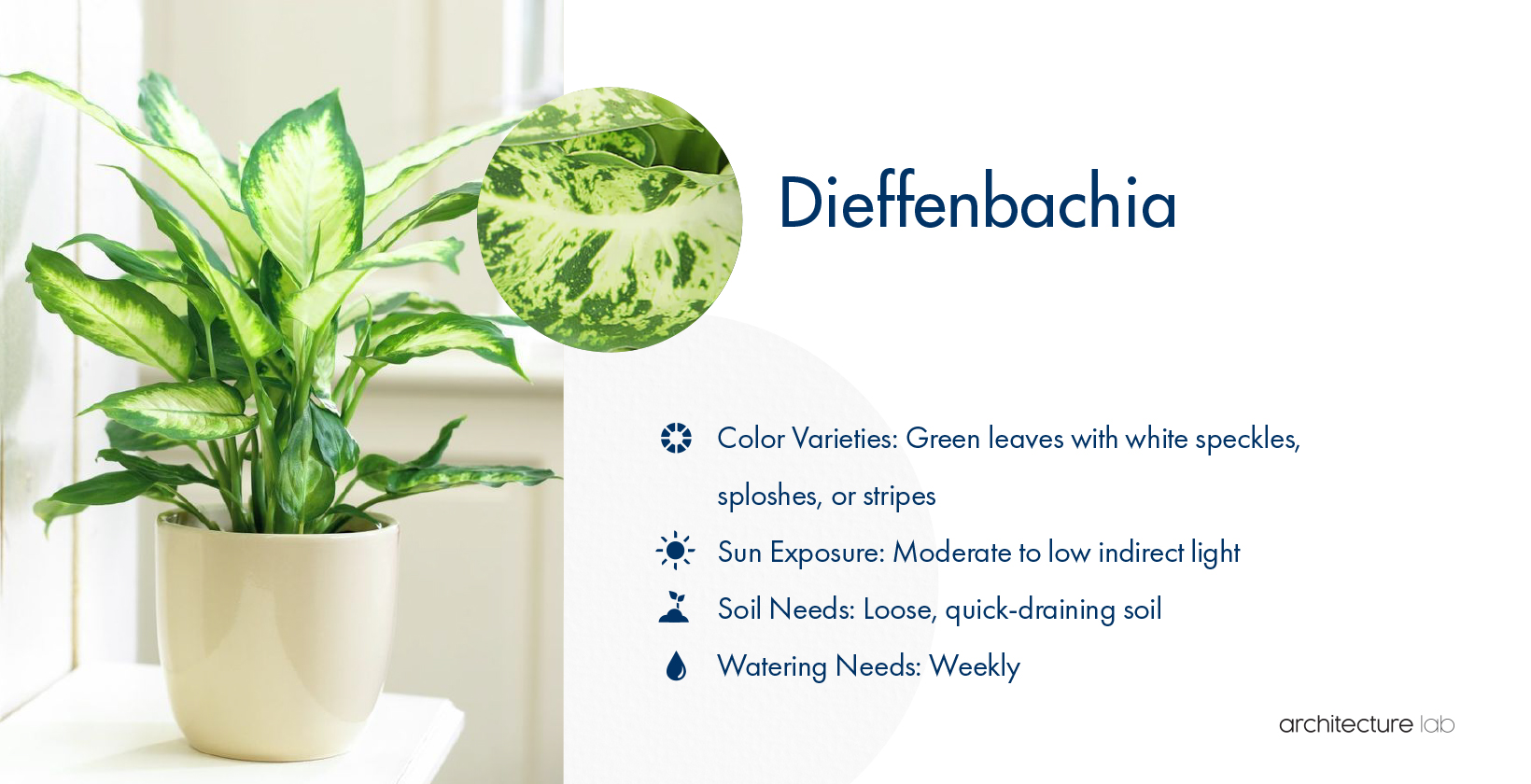
The Dieffenbachia plant is quite similar in appearance to the Aspidistra and Chinese evergreen plants but has a larger size. Sometimes called the ‘Dumb Cane,’ this plant has large, oval-shaped bright green leaves with pointed tips, with cream or white-colored speckles. The plant flowers very rarely, and the flowers are similar in appearance to peace lilies.
Indirect lighting is required for the plant, but it can be grown in low light conditions, though growth will be slower. I suggest placing it away from direct sunlight as that can scorch its leaves. The soil should be slightly moist but should not be soggy.
It will need watering when the top few inches of the soil become dry, though, in low light conditions, you can wait and allow it to dry a bit more. Dieffenbachia plants also love humidity, and an average humidity level of 60 and above will benefit the plant. When placing this plant in your bathroom, make sure the soil is not too dense.
Color Varieties: Green leaves with white speckles, sploshes, or stripes | Sun Exposure: Moderate to low indirect light | Soil Needs: Loose, quick-draining soil | Watering Needs: Weekly
24. Anthurium
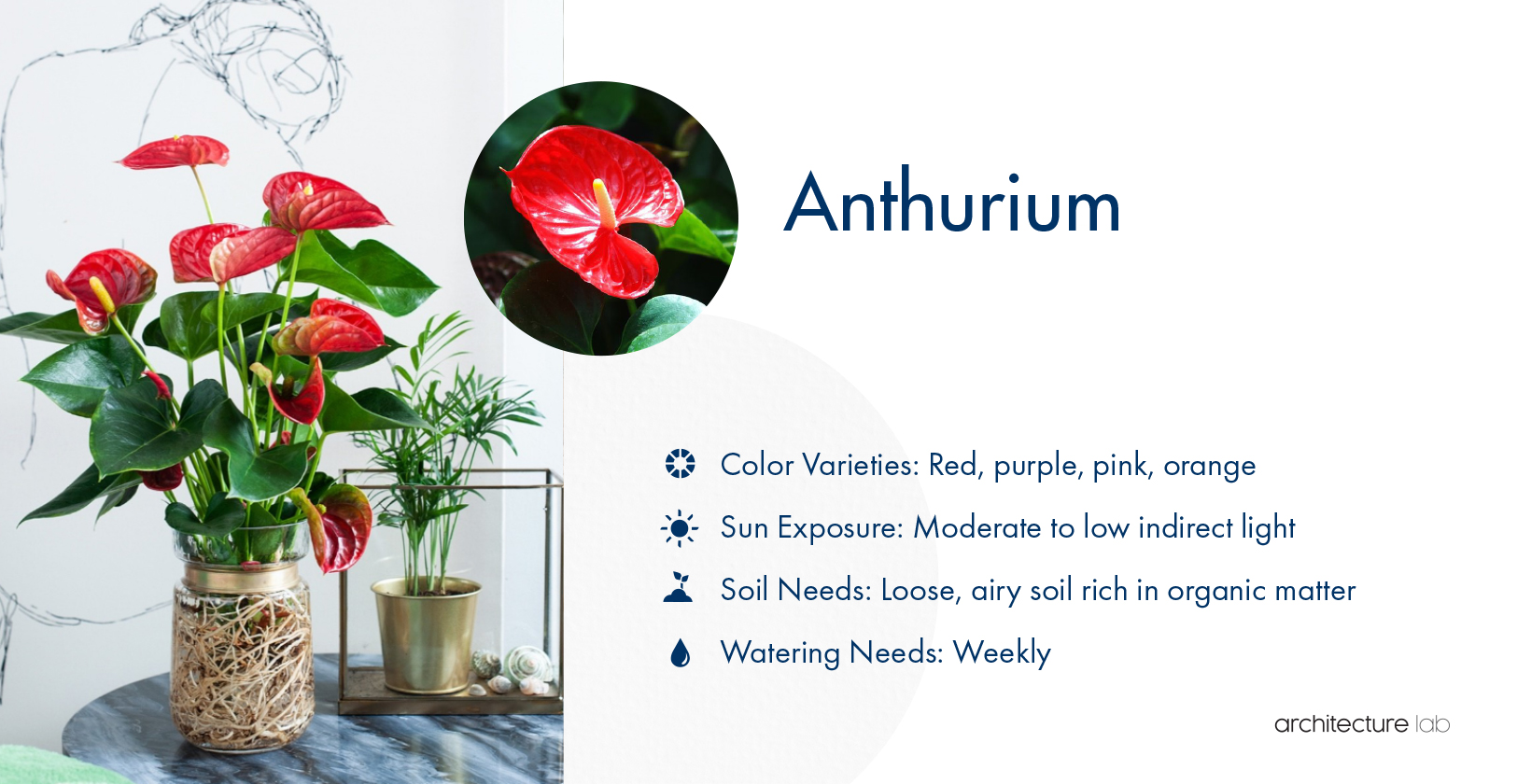
The anthurium plant is known for its heart-shaped waxy flowers, which are, in fact, leaves and can help add some color to your bathroom. Sometimes referred to as the flamingo lily or laceleaf, anthuriums are among the longest-blooming houseplants, flowering for most of the year. The green leaves also have a polished surface, which makes them look artificial.
Anthuriums prefer high humidity levels, so they are suitable for areas like bathrooms. Also, while the plants require bright sunlight to bloom, they can tolerate low light and grow well in such conditions. Moreover, they do not require much care and need to be watered just once a week. You can check the soil to ensure it is dry before watering.
The soil should be airy and loose to allow root development and proper water drainage, and should contain plenty of organic matter. Additionally, anthuriums grow moderately slowly, so I recommend placing them in smaller pots. But take care not to touch the sap produced since it is poisonous, here is a list of 24 other poisonous plants to avoid.
Color Varieties: Red, purple, pink, orange | Sun Exposure: Moderate to low indirect light | Soil Needs: Loose, airy soil rich in organic matter | Watering Needs: Weekly
25. Marble Queen Pothos (Epipremnum aureum)
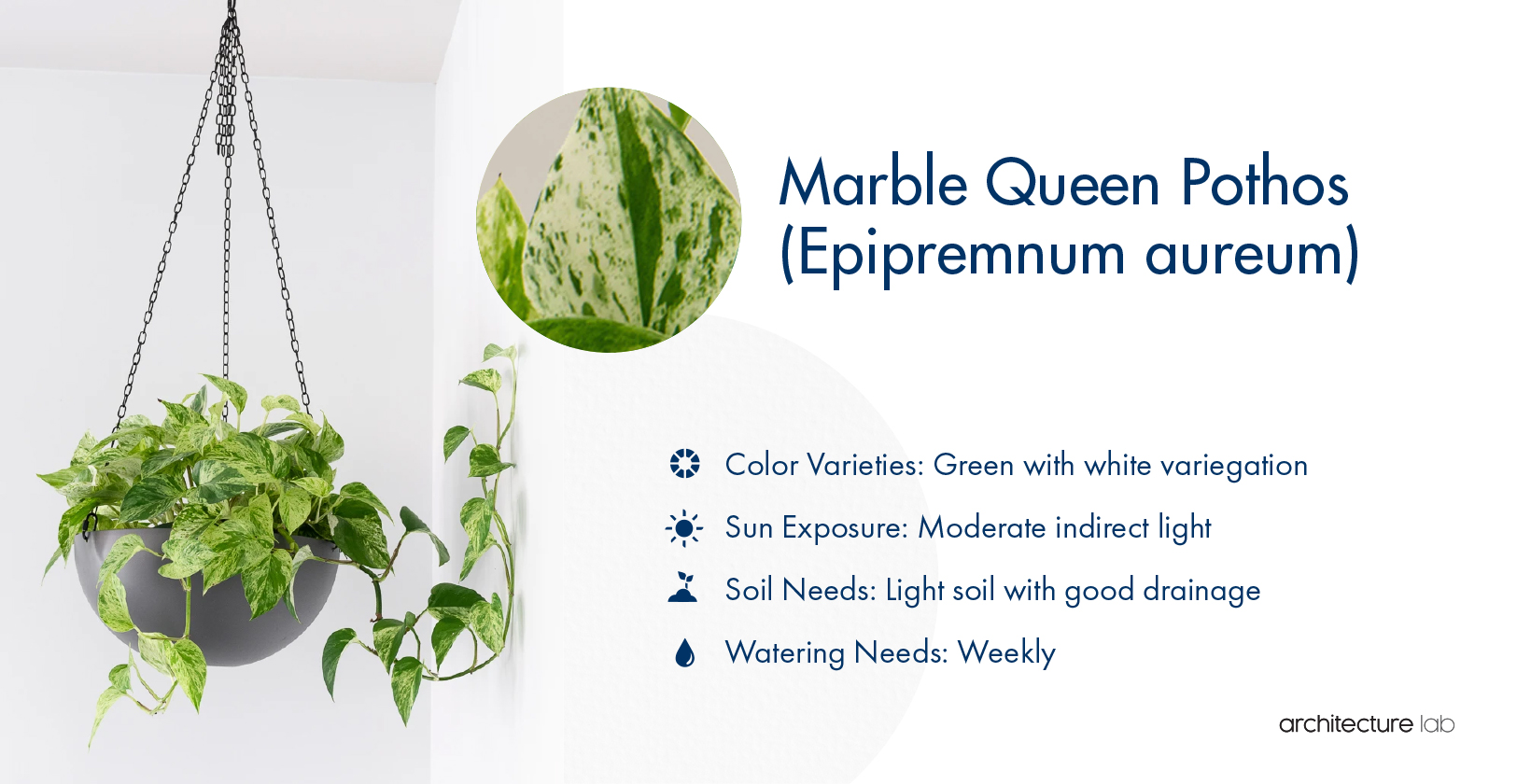
Like the golden pothos I’ve mentioned above, the marble queen pothos is another plant that can survive harsh environments and does not require much care. This plant has yellow and dark green patches on its leaves and long, trailing vines, making it perfect for your bathroom window sill.
Just avoid placing it in direct sunlight, as this pothos prefers moderate light and can survive in low light. While it should be watered regularly, this plant is quite drought resistant, so even if you forget watering occasionally, it won’t die. It should be watered when the top few inches of soil become dry.
While the marble queen pothos does not require too much humidity, it is not harmed by it. For planting it, use loose light soil with good drainage, which will allow the plant to grow up to 18 inches a month, to a maximum length of five feet.
Marble queen pothos plants look beautiful, but I would like to point out that they contain calcium oxalate, a poisonous substance.
Color Varieties: Green with white variegation | Sun Exposure: Moderate indirect light | Soil Needs: Light soil with good drainage | Watering Needs: Weekly
26. Lemon Lime Prayer Plant (Maranta leuconeura)
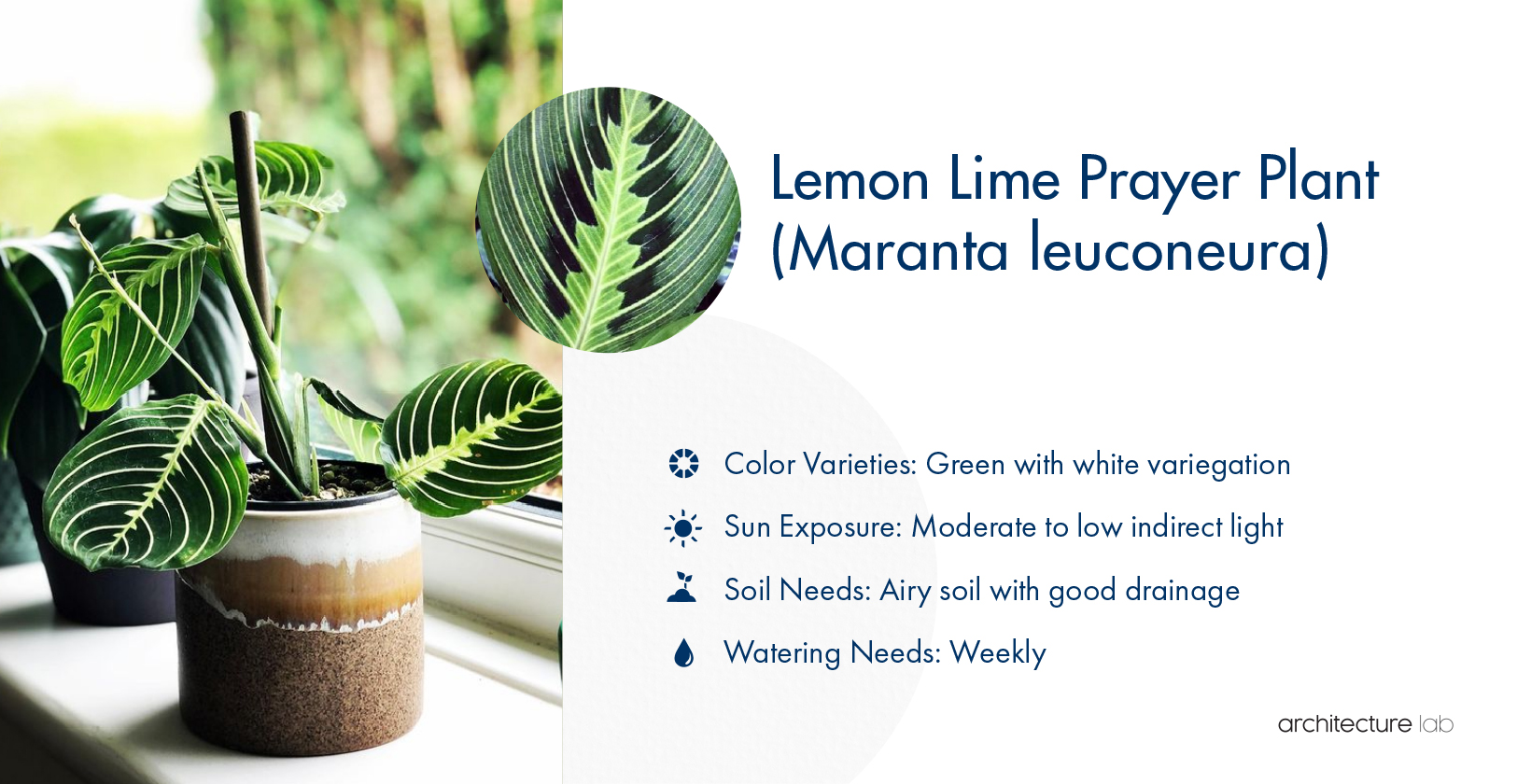
This plant takes its name from its large leaves shaped like praying hands. These leaves are oval-shaped and have white stripes and dark green spots, which look beautiful in all indoor environments. They also close up at night, which adds to their charm, and being a trailing plant, it can be used in hanging baskets, shower rods, or shelves.
The lemon-lime prayer plant can grow in different light conditions and is a good choice for bathrooms with very little light. Direct sunlight can damage the leaves, so I recommend placing them away from the bathroom window. You should always keep the soil moist, but avoid watering too much, as that can cause waterlogging.
Peat-based soils that are light and airy are the best for these plants, provided that they allow the water to drain freely. The temperature range should lie between 60 and 80 degrees Fahrenheit, and humidity should be high. This will allow the plant to reach its maximum size in a few years, which is around 12 inches.
Color Varieties: Green with white variegation | Sun Exposure: Moderate to low indirect light | Soil Needs: Airy soil with good drainage | Watering Needs: Weekly
27. Algerian Ivy (Hedera canariensis)
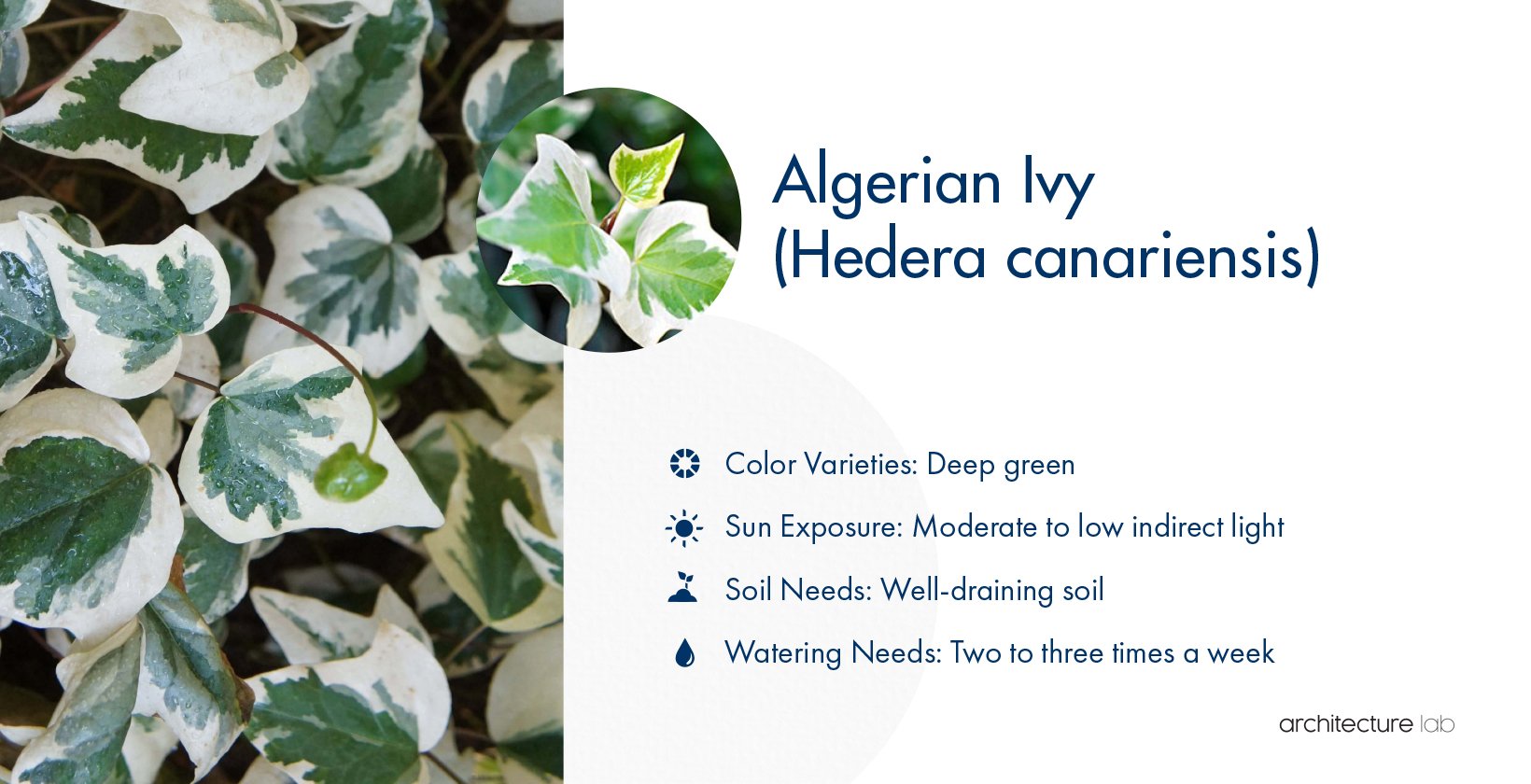
If you’re looking for an ivy plant besides English ivy, I suggest going with this one. The Algerian ivy is a fast-growing evergreen with lobed leaves that are deep green and have a glossy surface. It also has reddish stems, and while it does not usually flower, when it does, the flowers have a whitish-green color.
While this ivy absorbs most moisture from its roots instead of its leaves, it grows fine in extremely humid conditions, such as your shower. It is also drought-tolerant, but frequent watering can help ensure more vibrant colors. Since this plant grows best in partial shade and does not like direct sun, it is an excellent option among bathroom plants.
The best thing about this plant is that there are no temperature requirements, which means it can grow in most temperatures unless they are very extreme. So, you do not need to put in much effort caring for the plant, but it is toxic and should be kept away from pets and children.
Color Varieties: Deep green | Sun Exposure: Moderate to low indirect light | Soil Needs: Well-draining soil | Watering Needs: Two to three times a week
28. Swiss Cheese Plant (Monstera deliciosa)
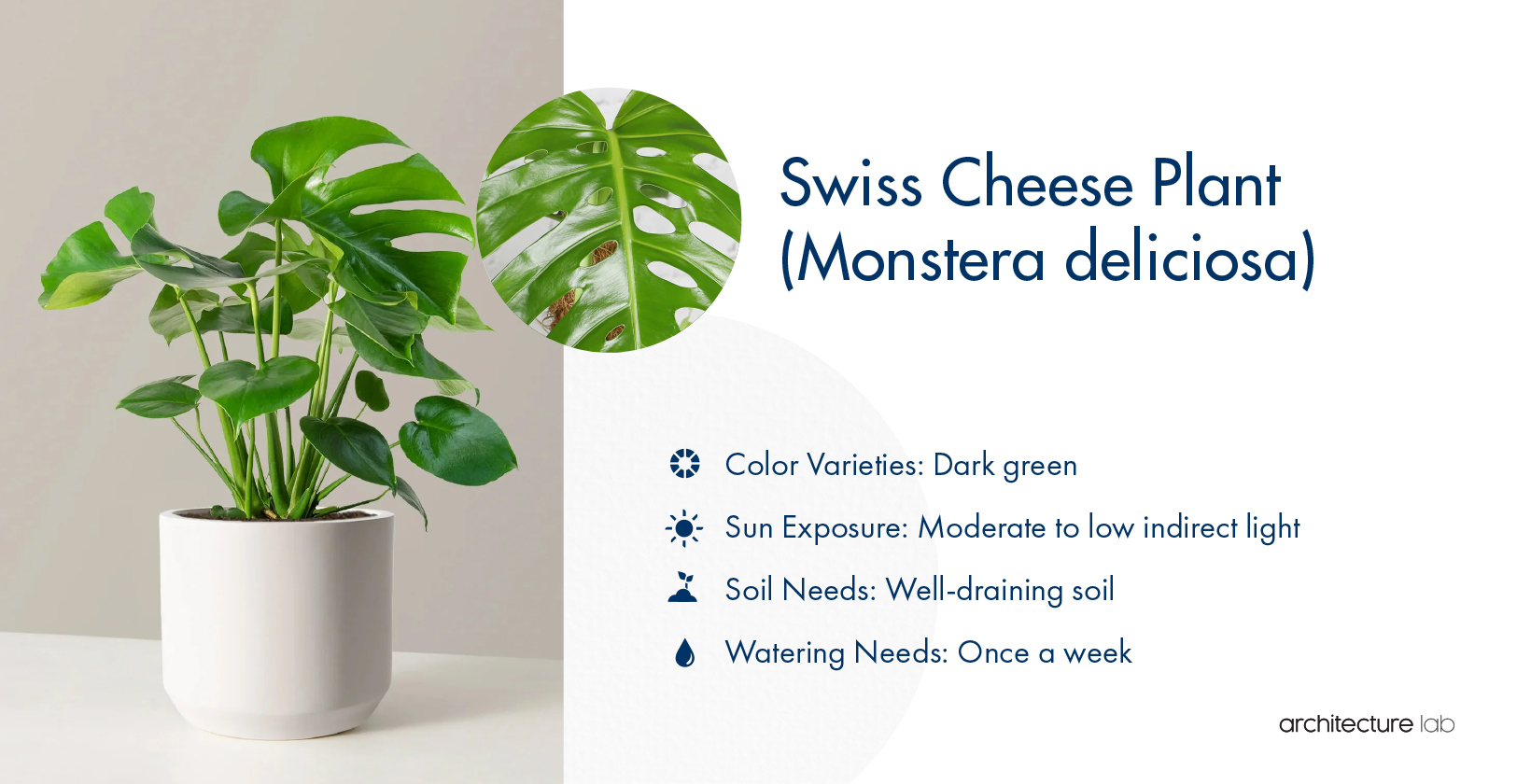
The Swiss cheese plant is native to Central America and is a perennial climber easily recognized by its huge leaves with several perforations. These holes make it appear similar to the dairy product it is named after. It also has aerial roots and thick stems and is related to the plant family Philodendrons.
Besides having a charming appearance, this plant is easy to take care of since it can grow in various lighting conditions. While moderate light is generally ideal, the Swiss cheese plant can also grow well in low light. Additionally, it does not require too much water, and watering it once a week is more than enough.
As for the soil requirements, nutrient-rich soils are well-suited, but I wouldn’t recommend using compost or materials like bark for these plants. Just ensure the water drains well, as roots left in standing water can start rotting quickly. If you plan to place this plant in your bathroom, keep it away from small animals like cats, as it is toxic to them.
Color Varieties: Dark green | Sun Exposure: Moderate to low indirect light | Soil Needs: Well-draining soil | Watering Needs: Once a week
29. Bromeliad (Bromeliaceae)
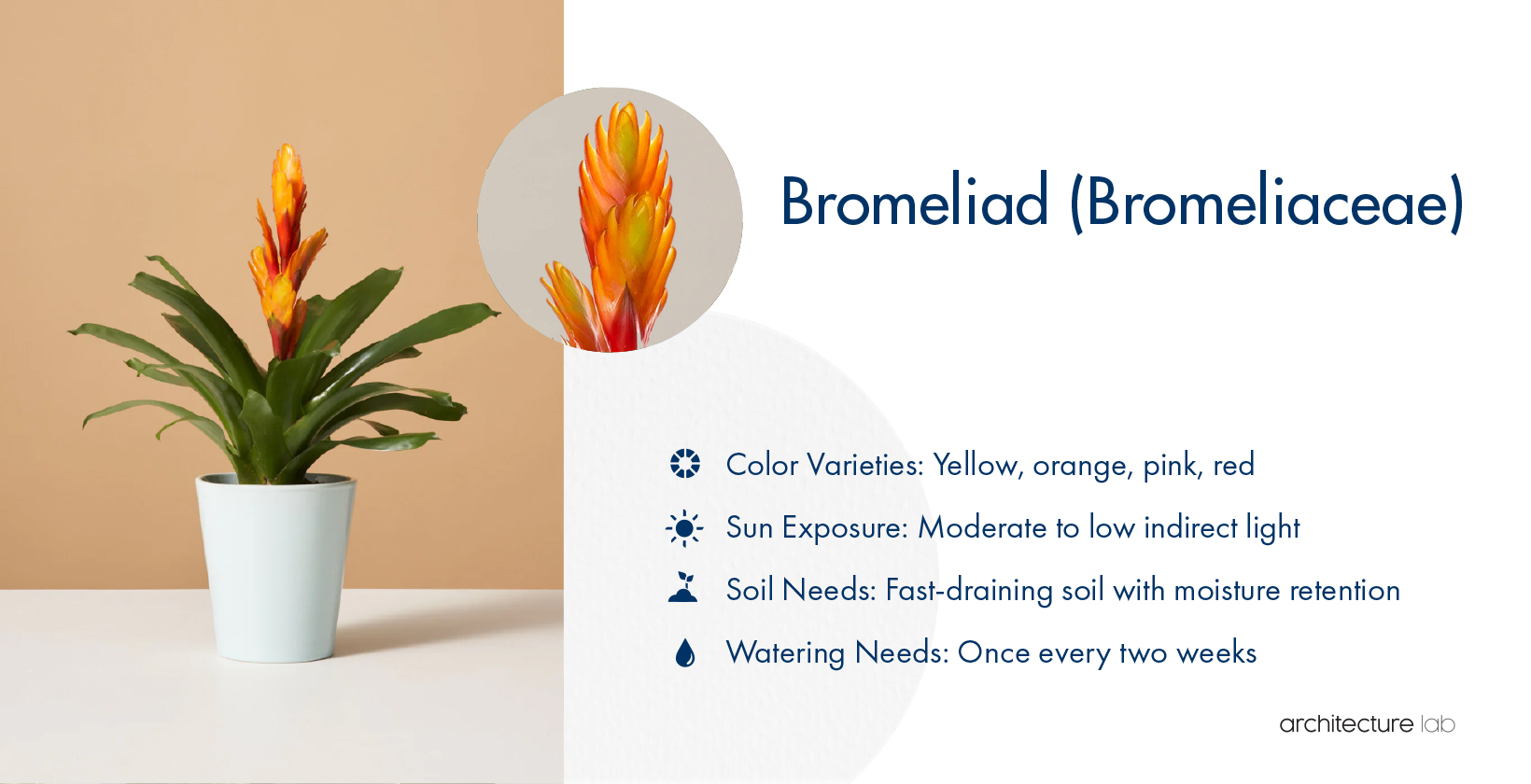
Several plant varieties are included under the Bromeliad family, and many can be grown in low-light conditions. These tropical plants can generally be distinguished by their sword-shaped leaves, which can be variegated. They also bloom at the center, and the flowers look quite exotic, making for a fantastic showpiece in your shower.
Being epiphytes, bromeliads grow on the surfaces of other plants and absorb moisture from the air. This means your bathroom can be the perfect environment for such plants, which can thrive in humid conditions. You just need to keep the plant away from direct sunlight, as it can burn the leaves.
Also, since bromeliads absorb moisture from the air, they are drought resistant and should not be overwatered. Since indoors they are likely to be grown in soil, use fast-draining soil that can retain moisture well. I recommend watering them once every couple of weeks in summer and weekly in winter.
The plants grow slowly and can take some time to bloom, but the flowers last for a long time.
Color Varieties: Yellow, orange, pink, red | Sun Exposure: Moderate to low indirect light | Soil Needs: Fast-draining soil with moisture retention | Watering Needs: Once every two weeks
30. Haworthia
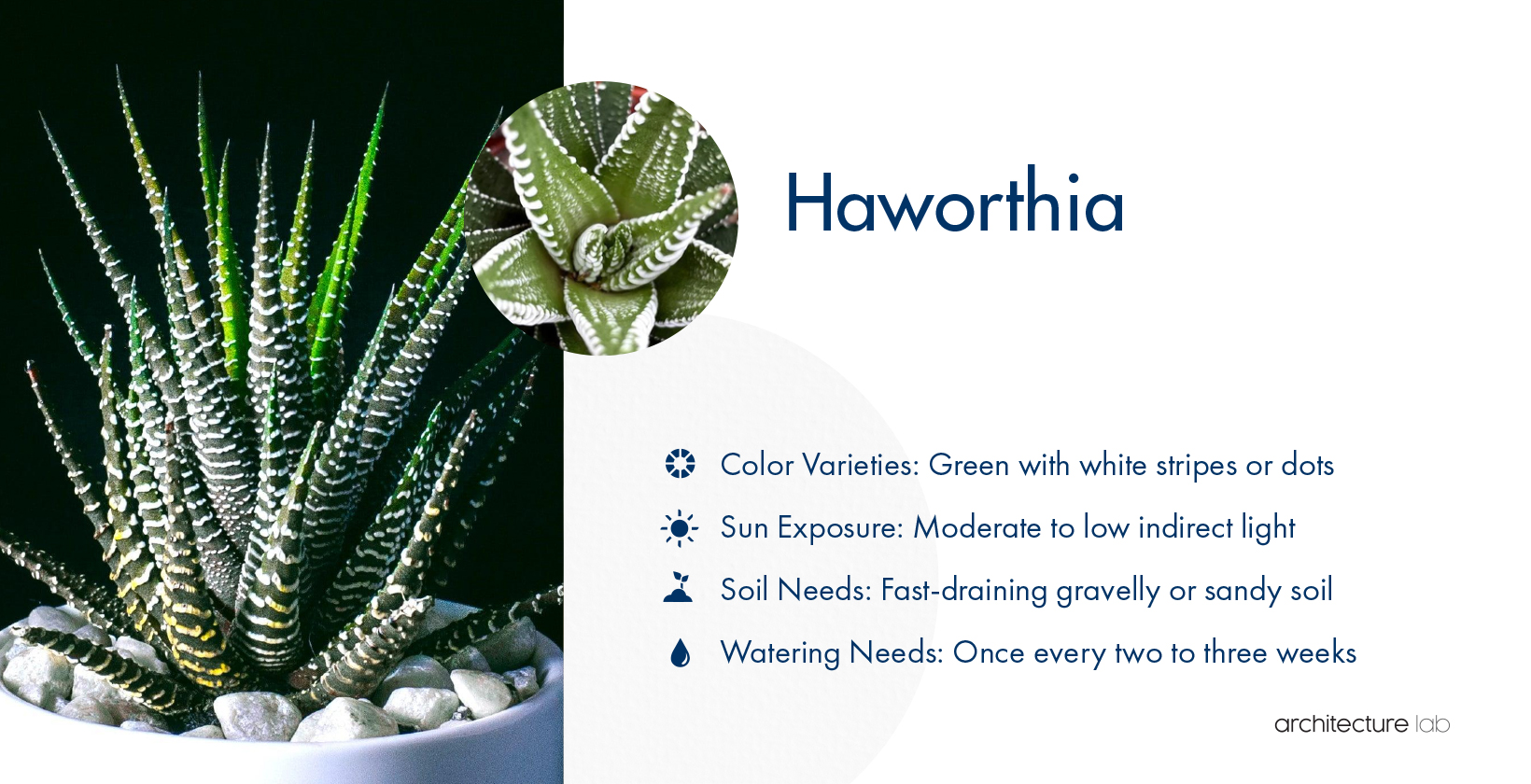
Haworthia is a genus of several succulent plants found in southern Africa. These plants appear similar to aloes, with tapering thick leaves that grow from a central rosette. Some varieties may have warts, and the leaves may slightly curl inwards, while others may have bubble-like leaves.
Irrespective of which variety you pick, these plants, which usually have a small size, look great indoors. They do not require much light, as they have adapted to growing in partial or complete shade in their natural habitat, though some varieties can grow in the sun.
That is also why they do not require frequent watering, and you only need to water them once every two to three weeks. I recommend using gravelly or sandy soil for your haworthia plants, which can drain quickly. This soil can even be mixed with pumice or perlite for better drainage.
Haworthia plants love high humidity, and temperatures between 70 and 95 degrees Fahrenheit are ideal for them to thrive. They also bloom during summer or autumn.
Color Varieties: Green with white stripes or dots | Sun Exposure: Moderate to low indirect light | Soil Needs: Fast-draining gravelly or sandy soil | Watering Needs: Once every two to three weeks
31. Inch Plant (Tradescantia zebrina)
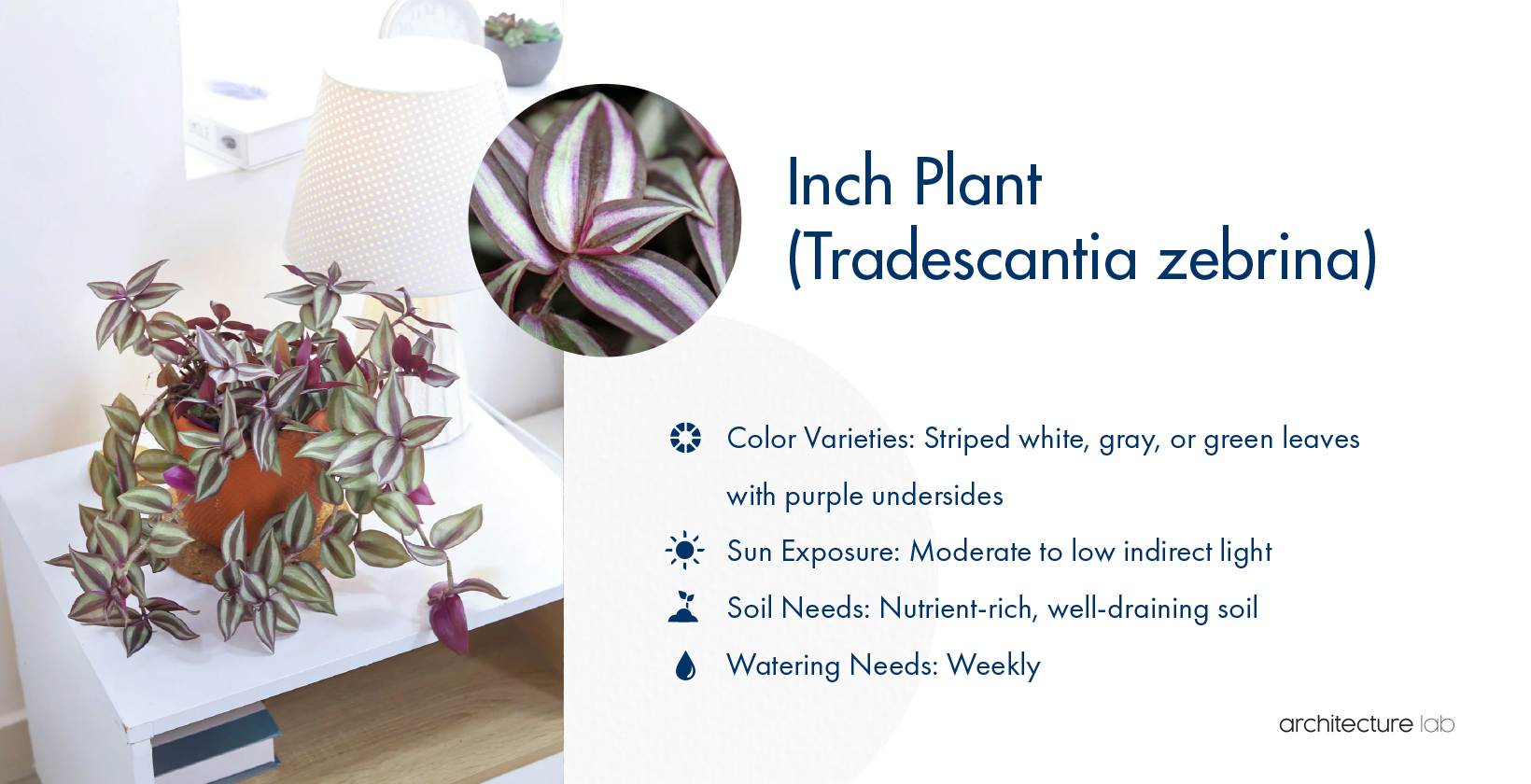
The inch plant was first discovered in Central America and is among the most beautiful vines you can grow indoors. It has variegated leaves that may be green, gray, or white, with the undersides having a purple hue. These oval-shaped leaves grow from the base of the plant’s stem, and the plant bears lavender-purple flowers occasionally.
This plant can grow in low light, so it can be placed in low-lit bathrooms and can even grow naturally in dense thickets with little light. It also prefers areas with a lot of humidity, ideally ranging from 50 to 70%, which is another reason it is a good bathroom plant.
Most of its water requirements can be met from moist air, but you should water it once a week. Keeping the topsoil moist will prevent the plant from drying out, and use nutrient-rich, well-draining soil for the plant. Under ideal conditions, the plant can grow up to six inches tall and two inches wide. The plant is not known to be toxic to animals or humans.
Color Varieties: Striped white, gray, or green leaves with purple undersides | Sun Exposure: Moderate to low indirect light | Soil Needs: Nutrient-rich, well-draining soil | Watering Needs: Weekly
32. Bamboo (Bambusa)
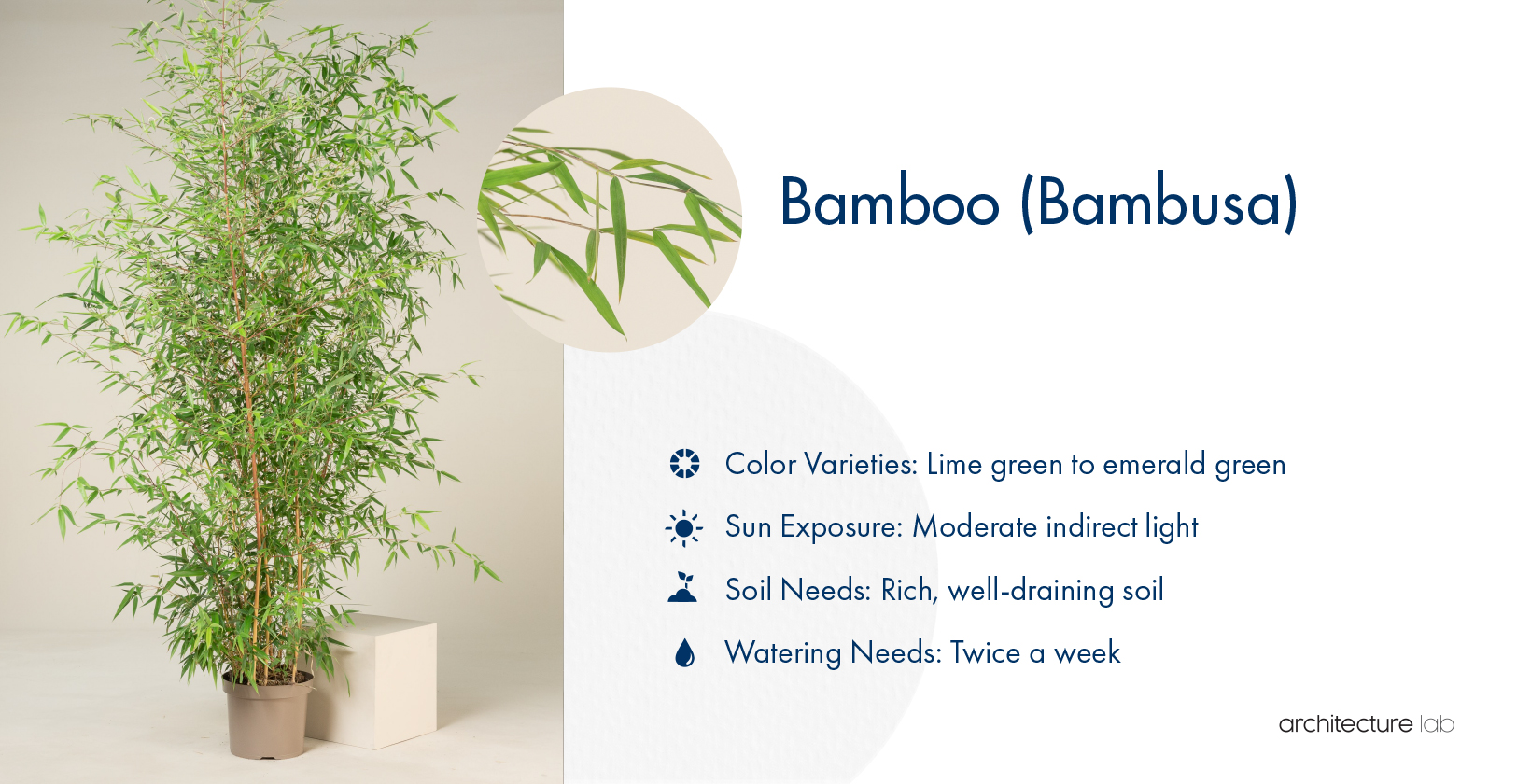
Found in several parts of the world, including Asia, South America, Australia, and North America, bamboo is the next plant I’ve included on this list. It is a species of grass with long, strong stems with several nodes and can be divided into two varieties, depending on the growing habits. Both species can be used indoors since this plant requires little light to grow.
You can place this plant in your bathroom, where it gets minimal indirect light and lots of humidity. Bamboo plants grow best when humidity is between 60 and 80%. In addition to high humidity, they require rich, fertile soils that allow water to drain easily.
Depending on the variety of bamboo you select, it can grow up to five to eight feet tall and may require a robust and sturdy container. The most important thing to remember when placing a bamboo plant in your home is that fresh plants contain cyanide, which can be dangerous if ingested. So, place it somewhere pets or children cannot reach.
Color Varieties: Lime green to emerald green | Sun Exposure: Moderate indirect light | Soil Needs: Rich, well-draining soil | Watering Needs: Twice a week
33. Money Tree (Pachira aquatica)
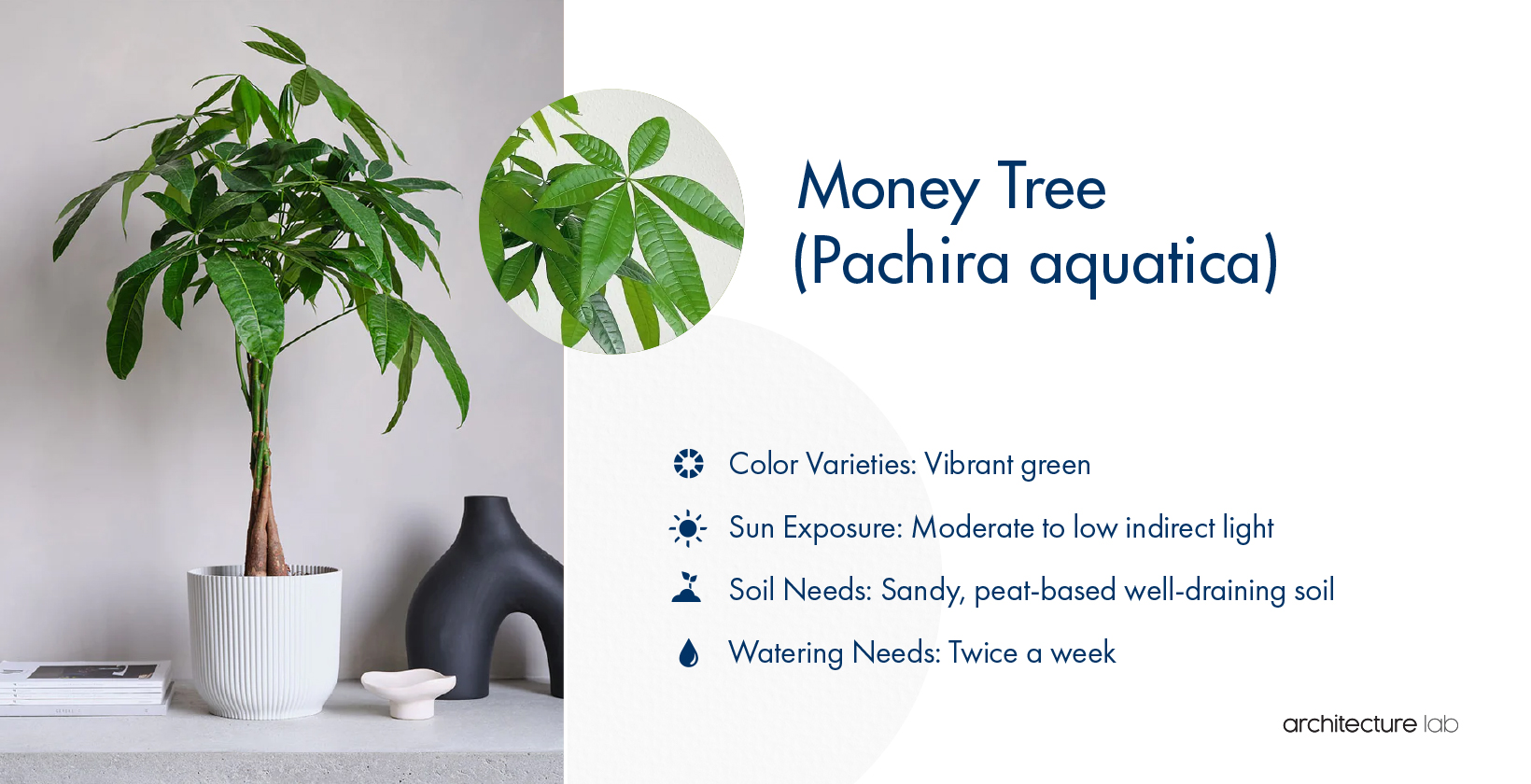
The money tree or money plant is known by many names, such as Malabar chestnut, Guiana chestnut, and water chestnut. It is a good-looking indoor plant that can provide a tropical aesthetic to your shower room. The plant has palm-like leaves that are bright green and a braided stem and is native to South America.
Ideal lighting conditions for this plant include moderate indirect lighting, but low light does not affect its growth. Because of this reason, I find it to be a suitable pick for bathrooms with very little light. It also does not require too much water, and you can just put two ice cubes in the pot each week for watering purposes.
The soil you use for this plant should be peat-based and sandy but should drain well. Alternatively, water the plant every one to two weeks, allowing the soil to dry out between the waterings. Money Tree is also one of the best air-purifying plants for bathrooms, which is another reason it is so popular.
Color Varieties: Vibrant green | Sun Exposure: Moderate to low indirect light | Soil Needs: Sandy, peat-based well-draining soil | Watering Needs: Twice a week
If you’re looking for a plant for your low-lit bathroom, there are lots of options to choose from. There are flowering plants, ornamentals, and even those with medicinal properties. I’ve mentioned the best options in this detailed guide, but there are a few things to consider when choosing between them.
Firstly, it is a good idea to avoid toxic plants if you have pets or kids at home. Or if you are opting for such plants, arrange for a place to keep the plant where it is out of reach for them. Additionally, consider the available space in the bathroom before picking a plant.
Some plants can grow to a large size, which may make them unsuitable for smaller bathrooms. So, select one that does not occupy too much space but helps improve the appearance of that area.


